#goddess jingu
Explore tagged Tumblr posts
Text

A commission for @neutronice's fic A Boy's Wish at Kagami Shrine! The story was a Secret Santa gift to me from Neutron so I'm honoured to get to be a part of this wonderful fic. Please go check out the story, it's amazing. Thank you for the gift, Neutron!
#this piece was a joy to work on#i dont do many background or environments or architecture but maybe i should#if youre curious the shrine is a real shrine in karatsu in japan which is the town hasetsu is based on#yes this is sneakily yuri on ice art#you really thought id post two non yuri on ice illustrations in a row?#you overestimate my ability to exist outside this fandom#anyway getting to first draw this really cool shrine and then getting to pick it apart was so fun#thinking about how it would realistically wear and tear was so fun#also copper roofing looks incredible no matter if its new or entirely oxidised#two looks in one#granted you have enough time to wait for the second one to fully appear#but im patient#(no im not)#yuri on ice#yuri on ice fanart#fanart#art#arom antix art#arom antix#goddess jingu
19 notes
·
View notes
Text
Sean bienvenidos japonítasarqueológicos a una nueva entrega, en esta ocasión vengo a aclarar dudas sobre la diosa Amaterasu dicho esto comencemos. - Amaterasu aparece en los libros kojiki y Nihonshoki que son los más antiguos de Japón, dicha diosa simboliza el sol, la luz, la compasión y la verdad. Además Representa la casa real con la flor de crisantemo, también ha recibido otros nombres como: "Hirume" y "Mukatsuhime. Sus padres eran izanagi(dios creador de Japón) e izanami(diosa del infierno), izanagi al quedar contaminado de la tierra de Yomi fue a purificarse y al quitarse la ropa fueron naciendo los demás dioses y ella nació de su ojo izquierdo. Amaterasu gobernaba el Takamanohara y su hermano Susanoo era el dios del mar. - Amaterasu, estaba asustada por su hermano menor y decidió esconderse en una cueva profunda en Takamagahara llamada "Ama no Iwato" y bloqueó la entrada. Este es el famoso “Amaniwato no Kamigakure”, que el pueblo japonés sigue recreado como una de sus muchas tradiciones populares. - Como ya hablamos en otras publicaciones el sintohismo, es una religión autóctona de Japón que durante la era Meiji sería utilizada para clasificar lo japonés y de lo que no era japonés, los japoneses nunca dejaron el sintohismo de lado. La simbología de la bandera japonesa se remonta desde tiempos muy remotos. - La diosa Amaterasu tiene unos 5000 templos dedicados a ella y se llaman Shinmei Jinja. El templo se localiza dentro del santuario Ise Jingu, también conocido como (oise-san) y el templo se llama Kotai jingu. En la ciudad de Iwato en la prefectura Miyazaki se encuentra el santuario Amanoiwato donde se dice que Amaterasu fue establecida como deidad principal. Amaterasu lo podemos traducir como: Diosa del sol o como diosa solar. - 新作へようこそ、今回は天照大神の疑問を解き明かすということで、始めましょう。 - 日本最古の古事記や日本書紀に登場する天照大神は、太陽、光、慈悲、真実を象徴しています。また、菊の花で王家を表し、「ヒルメ」や「ムカツヒメ」などの別名も持っています。彼の両���はイザナギ(日本の創造神)とイザナミ(地獄の女神)でした。ヨミから大地を離れ、身を清めに行き、服を脱ぐと他の神々が生まれ、左目から生まれました。 アマテラスは高天原を治め、弟のスサノオは海の神でした。 - 弟を恐れたアマテラスは、高天原の深い洞窟「天の岩戸」に身を隠し、入口をふさいだ。これが有名な「天岩戸の神隠れ」で、日本人は多くの人気のある伝統の1つとして再現し続けています. - 他の出版物ですでに説明したように、神道は日本固有の宗教であり、明治時代に日本人とそうでないものを分類するために使用されましたが、日本人は決して神道を放棄しませんでした.日本の国旗のシンボルは、非常に遠い時代にまでさかのぼります。 - 天照大神を祀るお寺は約5,000あり、神明神社と呼ばれています。このお寺は伊勢神宮内にあり、通称「お伊勢さん」とも呼ばれ、皇体神宮と呼ばれています。宮崎県岩戸市には天照大神を主祭神とする天岩戸神社がある。アマテラスは、太陽の女神または太陽の女神として翻訳できます。 - Welcome to a new installment, this time I come to clarify doubts about the goddess Amaterasu, having said that, let's begin. - Amaterasu appears in the Kojiki and Nihonshoki books, which are the oldest in Japan, this goddess symbolizes the sun, light, compassion and truth. It also represents the royal house with the chrysanthemum flower, it has also received other names such as: "Hirume" and "Mukatsuhime. His parents were izanagi (creator god of Japan) and izanami (goddess of hell), izanagi when contaminated by the earth from Yomi she went to purify herself and when she took off her clothes the other gods were born and she was born from her left eye. Amaterasu ruled the Takamanohara and her brother Susanoo was the god of the sea. - Amaterasu, scared of her younger brother, hid in a deep cave in Takamagahara called "Ama no Iwato" and blocked the entrance. This is the famous "Amaniwato no Kamigakure", which the Japanese people continue to recreate as one of their many popular traditions. - As we have already discussed in other publications, Shintoism is an indigenous religion of Japan that during the Meiji era would be used to classify what is Japanese and what was not Japanese, the Japanese never abandoned Shintoism aside. The symbology of the Japanese flag dates back to very remote times. - The goddess Amaterasu has about 5,000 temples dedicated to her and they are called Shinmei Jinja. The temple is located inside the Ise Jingu shrine, also known as (oise-san) and the temple is called Kotai jingu. In the city of Iwato in Miyazaki Prefecture is the Amanoiwato Shrine where Amaterasu is said to have been established as the chief deity. Amaterasu we can translate it as: Goddess of the sun or as solar goddess.
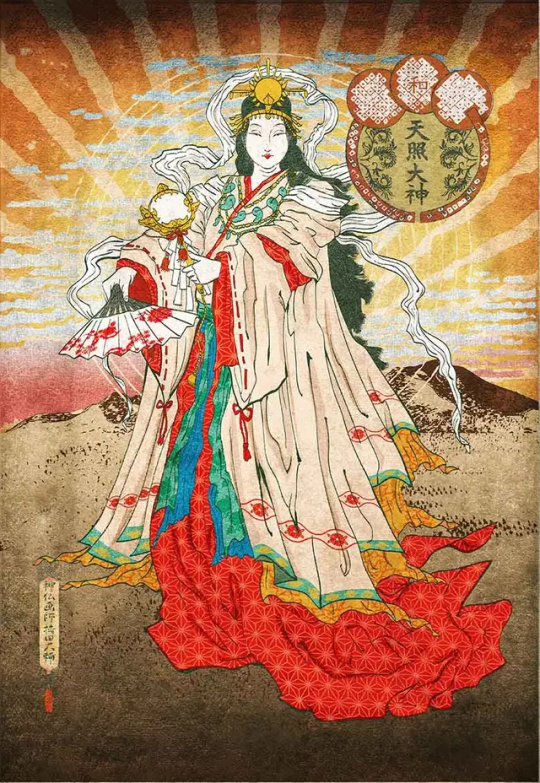
#日本#アマテラス#アート#写真#ユネスコ#文化#神話#神道#シントイズ���#japan#amaterasu#art#photo#unesco#culture#mythology#synthology#sintoism
60 notes
·
View notes
Text
THEORY: PEACH BLOSSOM COOKIE and Dark Cacao's relation to Journey to the West
Okay okay, so hear me out. Peach Blossom Cookie is based on the Chinese Goddess Xiwangmu.
I'll start by how I got to this conclusion. The entirety of the Dark Cacao storyline so far has had a lot of Journey to the West elements to it.
Stormbringer Cookie's legendary costume: Splitter of the Seas for example. Inside the video trailer advertising the costume, there is a scene showing the Heaven Splitter glowing underwater. This is a scene highly reminiscent of the Golden-banded staff Ruyi Jingu Bang, a treasure of Ao Guang, the dragon king of the Eastern Seas. The staff would eventually come under the ownership of Sun Wukong, and upon finding its true master, the staff would flow. This can be seen happening in the image below.

Not only that, but Stormbringer's costume also has a dragon scale-like texture on it referencing Ao Guang, and she also wears a golden headband much like Sun Wukong.

Continuing on with this theme of Journey to the West, the mountain in the Beastraid parallels Wuxing Mountain, which is the mountain Buddha traps Sun Wukong underneath. The Mountain is also known as the Five Elements Mountain or the Five Finger Mountain, another piece of evidence pointing to the similarities between Journey to the West and Buddha since the Beastraid attacks mainly using hands.

With the connection to the mountain and Journey to the West secured, I can move on to Peach Blossom Cookie. The first hints of Peach Blossom Cookie's inspiration were the peach tree and the peach tree surrounding him. In Journey to the West, there is one type of peach that is heavily involved in the story, called the Peaches of Immortality.
In Chinese Taoist folklore, the Goddess Xiwangmu lived in her palace on the mythological Mount Kunlun, where she was said to have grown an orchard of peach trees that bore peaches every three thousand years. The peaches, once ripened, would bestow immortality and longevity on any human who ate them. The third type especially has a striking similarity to Dark Cacao and Mystic Flour's SoulJams. "The third variety is the most extraordinary. These Peaches of Immortality have purple streaks and their stones are a pale yellow. They ripen only every 9,000 years and whoever eats them lives eternally and enjoys a rank equal to that of the Sun and the Moon (which are actual living beings in Chinese mythology)."
In the story of Journey to the West, Sun Wukong was asked to guard the immortal peaches. Instead, he ate them all himself and continued to create chaos. As punishment, he was imprisoned for 500 years under the Five Finger Mountain. This helps connect the peach trees on the Beastraid mountain with the story. Peach Blossom's skill is also called "Heavenly Fruit", again suggesting the similarities.

Now to focus on the Goddess Xiwangmu herself. She was the one in charge of the Immortal Peaches and was known as the Queen Mother of the West. Coincidentally enough, The Flour Peak of Transcendence is also located at the bottom west of Beastyeast.
In multiple old artworks of the Goddess Xiwangmu, she is depicted to share a very close semblance to Peach Blossom Cookie. Such as the colouring, and even the hair bun, which has been replaced by a literal peach.


Another feature that suggests that Peach Blossom may be of divine nature is the floating ribbon he wears, which is called a Pibo, or Pei. These were most commonly worn by women and are often used in media to showcase that a character has a high amount of spiritual energy. Stormbringer, Mystic Flour, and one of the five characters shown playing Go (A Chinese strategy board game for two players in which the aim is to capture more territory than the opponent by fencing off empty space) all wear a pibo showcasing their powerful status.
(Also, since I'm talking about them, they are likely the Wufang Shangdi, the "Five Regions' Highest Deities" or "Highest Deities of the Five Regions". They can also be known as the "Five Colour Deities", as each is known for a specific colour representing them. The Bluegreen Deity, The Yellow Deity, The Black Deity, The Red Deity and The White Deity. Each has an animal form that is the dragon corresponding to their colour.)

The Goddess Xiwangmu was also the only deity in the Chinese Pantheon with the ability to talk directly to humans, using her peach tree as a link between Earth and Heaven. However, she did not speak to just any human.
She would speak exclusively to Chinese Emperors in order to give them the Mandate of Heaven and teach them the secrets of immortality. The Mandate of Heaven was considered the emperor’s divine right to rule. The first emperor to claim the Mandate of Heaven was Emperor Shun of Shanxi, and it is said that on the day he was crowned, five planets had aligned. Though in most of her interactions with the mortal kings, they would always fail her tests and remain mortal.
This can be seen within the newest Cookierun Trailer where Dark Cacao encounters Peach Blossom Cookie at the peach tree and he offers him a place to sate his hunger.
It should also be noted that Xiwangmu lives at Mount Kunlun, which is one of the longest mountain chains in Asia and extends more than 3,000 kilometres. Dark Cacao wonders about "How many steps" he has climbed and is shown to be exhausted, which suggests that he has walked a very long way.

Taking another close look at the scene, there are three birds settled around the small pond. The twelfth chapter of the famous Chinese text Shanhai Jing, or the "Classic of Mountain and Seas", describe Xiwangmu with three birds:
'She is the controller of the Grindstone and the Five Shards constellations of the heavens. Xiwangmu rests on a stool and wears an ornament on her head. She holds a staff. In the south, there are three birds from which Xiwangmu takes her nourishment. They are found to the north of the Kunlun mountains.'
However, Xiwangmu was also thought to have been a demonic figure who caused disease, floods, and other major disasters. The opinion of her began to change around the time of the Tang Dynasty, and following this shift, she was seen as a repentant, benevolent goddess. Whether or not Devsis will include this aspect of her in Peach Blossom Cookie is unclear, especially with the interactions between Cloud Haetae Cookie and the Pale Ailment.
(And here's an image of Emperor Shun, doesn't that hat look familiar?)

Dark Cacao's newly awakened title as the "Dragon Lord" is interesting too, as it ties back to Stormbringer and the origin of the Ruyi Jingu Bang (which parallels the Heaven Splitter which had been used to split the Black and White dragon into two. The two dragons are now apparently helping Dark Cacao.)
#fyp#cookie run kingdom#cookie run#crk#cr kingdom#game theories#peach blossom cookie#dark cacao cookie#stormbringer cookie#journey to the west mentioned#a lot#i did a lot of research for this#Chinese mythology#I went rabid over this in the discord server#apparently Xiwangmu is also seen as the goddess of death? So that's ominous#what does this mean for the story#feed us devsis#i'm starving
95 notes
·
View notes
Text
Family of Sages
I mentioned in this post about possible Celestial Water Monkeys; that one Ming-dynasty opera (written nearly 200 years before the Jttw novel) depicts the "Wuzhiqi" (a simian water demon) as a sister to Sun Wukong.
@journeytothewestresearch did an article or two on this particular play, and how there's a possibility of there being multiple "Great Sages" throughout folklore.
The play itself is pretty bawdy given that it's writer was known for adult comedy; with "Sun Xingzhe" being a bit of horndog (only stopped by the circlet), based on a popular cryptid of the time infamous for stealing women.
Other details include;
Red Boy (true name being Ainu’er) being the son of the Bodhisattva Manjushri and the ancient demon-mother-goddess Hariti (comparable to the Echidna of Greek mythology).
The nine skulls on Sha Wujing's neck representing the nine previous lives of the Golden Cicada. (cool af)
Zhu Bajie being afraid of nothing (hah!) but Erlang's dog Xiaotian Quan.
Princess Iron Fan being unmarried, to which Sun Xingzhe offers to be her husband (guess people were shipping them even back then, explains Goku and Chichi).
Tripitaka returning to Chang'an without his pilgrim buddies, instead the Buddha gives him four bodyguards of his own for the return trip. The demons aren't allowed go back East. Kinda sad.
So it's best to take the characterisation with a grain of salt, though it has some cool ideas.
The family sound off is presented as this:
"We are five brothers and sisters: my elder sister is Lishan Laomu [離山老母, Venerable Mother of Mount Li], my second sister Wuzhiqi Shengmu [巫支祇聖母, Holy Mother Wuzhiqi]; my older brother is Qitian Dasheng [齊天大聖, Great Sage Equaling Heaven], I myself am Tongtian Dasheng [通天大聖, Great Sage Reaching Heaven], and my younger brother Shuashua Sanlang [耍耍三郎]"
Wukong introduces himself as "Tongtian Dasheng [通天大聖, Great Sage Reaching Heaven]". But his older brother has the title of Qitian Dasheng [齊天大聖, Great Sage Equaling Heaven].
Another later story mentioned in the article has the "Cinnabar Cloud Great Sage/Danxia Dasheng"; a red-furred staff-wielding monkey who acts as an antagonist towards the main goddess character. Curiously is described as both a peach thief, a survivor of Laozi's furnace, and a frequent identity-stealer (possible Six Eared Macaque?). He is punished for being so naughty by getting neutered (ouch).
And of course there is the God of Thunder Leigong aka "Sire/Duke of Thunder", who is often depicted as a celestial monkey/ape working as the muscle and executioner for the Jade Emperor. Became immortal after eating a Peach dropped by a fox demon (Jiuweihuli?) arguing with Celestial soldiers. Is married to the Goddess of Lightning Dianmu, who lights up the sky to help her husband see his targets. He is said to be one of Five Brothers, leading to more connections.
So theres;
Lishan Laomu/"Venerable Mother of Mount Li" - Eldest sister/sibling. Curiously named after a popular goddess of the same name said to be equal in power to Nüwa, and possible Mother Nature itself. Said goddess appears in Jttw as a companion of Guanyin, and helps out Wukong when the rest of the hang were poisoned.
Wuzhiqi Shemu/"Holy Mother Wuzhiqi" - Second elder sister. Her name is associated with an aquatic flood demon with a stretchy neck - bound to the bottom of mountain/sea by Yu the Great (original owner of the Ruyi Jingu Bang) with iron chains.
Qitian Dasheng/"Great Sage Equaling Heaven" - older brother. Has the traditional "Great Sage Equal to Heaven" title. Makes me think of Dasheng from HIB.
Tongtian Dasheng/"Great Sage Reaching Heaven" - second brother aka the version of Sun Wukong/Xingzhe in the play. Is closer to "Quagmire" than Sun Wukong tbh.
Shuashua Sanlang/"Playful Third Brother" - youngest brother. Not much is said about him. His name literally means "Playful Third Brother". Might be the baby of the family.
+Danxia Dasheng/"Cinnabar Cloud Great Sage" - red-furred Wukong double. Got neutered for being naughty.
+Leigong/Duke of Thunder - Actual thunder god.
This gang of monkeys siblings is likely what led to the depiction of the "Four Stalwart Generals" who are Wukong's closest monkey companions. But now I'm imagining an universe/au where the Stalwarts are all similarly orphaned celestial monkeys of deferring elements who adopted one another.
Danxia/Cinnabar Cloud is an odd mix of both Wukong and the Six Eared Macaque. Possible kid? Maybe inspired ideas of Wukong being red furred. His shenanigans even remind me of Monkey from the netflix Monkey King (2023).
And of course Leigong... Jade Emperor sends a monkey to kill a monkey, and is shocked when Wukong survives. Leigong is like an old blue-collar worker who refuses to work if it violates his union rights - even orders from the King of the Universe.
#stone monkeys#the four stalwarts#the other celestial primates#sun wukong#jttw#journey to the west#leigong#duke of thunder
30 notes
·
View notes
Note
Hehehe, hello dear author. I have a somewhat peculiar request for Poseidon. Let's say that at a meeting or party some time after Ragnarok, Amaterasu arrives with a miko assisting her, which the goddess treats as her daughter and as soon as she sees Poseidon she does her best to prevent Poseidon from noticing the priestess. Since Amaterasu knows the story of Medusa and this special human is like a daughter to her. The miko is from a modern era, but she had a peculiar childhood. Since she and/or she was born, she was consecrated to the Grand Shrine of Amaterasu, being the only woman among her brothers. Her parents only visited her at the temple to demand perfection, asking the monks and superior priestesses to leave her in isolation if she did not meet their expectations to the letter, the monks could not oppose since her family was of high social hierarchy and very rich. Basically, she suffered mental and sometimes physical damage from the scars left from training her with weapons related to the sun goddess. And it was at dawn, while he was serving his punishment in isolation, that Amaterasu appeared to him, and lamented everything that his followers had done. From that day on, the goddess promised that she would always be with her, and basically Amaterasu was the one who he would gossip while they hung out in isolation. she y/n she died defending the temple from a too powerful yokai, and Amaterasu collected her soul and performed her funeral personally, as well as driving her y/n's family out of her lands. For this reason Amaterasu is so jealous of y/n, especially against Poseidon due to the tyrant of the seas' fetish for virgin priestesses. But surely Poseidon is worth half a peach and somehow he takes the miko to his domain to try to woo her, and y/n knowing that he will not beat Poseidon in a fight, he always evades him saying that he is not interested in being with a married man (Amphitrite) while trying to find a way to escape every day. And Amaterasu is about to start a war against Hades, since the latter stands in the way of the sun goddess breaking Poseidon's face.
-Your life was only better after you died.
-It was a sad truth, but a truth, nonetheless. You were the only daughter born to a high society family with four older brothers and one younger brother.
-To your parents, you were useless, as only boys mattered to them, sons to carry on their lineage.
-They got rid of you the first chance they had but did it in a way where nobody would accuse them of being bad parents, they gave you to the Ise Jingu, the holy Shinto shrine of Amaterasu, where the goddess is rumored to live, an honorable fate.
-Your life became nothing but chores and going to school, only being able to attend through middle school, the mandatory educational requirements in Japan.
-However, you worked hard, proving yourself to the High Priestess and the priests who oversaw the temple grounds, and you were conscripted to become a priestess yourself.
-Your family benefited from your promotion, using it as publicity for them and their sons that their only daughter was devoted to a life serving in a temple as a priestess.
-However, this came at a price, due your parents being so wealthy, giving massive donations and getting many other high society families to donate large amounts, their instructions were clear: you had to be perfect, no mistakes, and if any were made, you were to be locked away and punished.
-Unable to risk the donations, the High Priestess accepted the terms.
-You tried your best, being diligent with your work so you would make any mistakes, but their constantly watching eyes, even the smallest mistake had them throwing you into a small isolated room with no windows, sometimes after whipping the tops of your hands so you would learn.
-You struggled with their treatment, sometimes punishing you by not feeding you for days, isolating you, you were quickly beginning to look sick, but those in charge were too blinded by their greed.
-You could only stare in the darkness of the room, no windows to illuminate anything, the only source of light being the sun peeking through the small cracks.
-A hand on your head startled you, flinching in fear as you could barely move, turning your heard to see the most beautiful woman you have ever seen, glowing as if the was the sun herself.
-You eyes were wide and full of tears as she pulled you into her arms, weeping softly as she held you, “How could they hurt someone so young- so small.”
-You instantly knew this was Amaterasu herself, your own tears welling as you broke down, sobbing into her chest, but she didn’t berate you, she just let you cry, giving you the soft affection that you so desperately wanted.
-From that day on, Amaterasu was always with you, but nobody could see her but you, as she said they were not worthy to see her.
-She had healed your wounds, kept you warm at night, became a friend, a mentor, and a mother to you, doting on you so gently.
-When she had to leave you for a short while, you were terrified, clutching her kimono, which broke her heart, but she promised to return to you.
-Without her divine protection, which had shielded your mistakes from the eyes of those in charge of the temple, so you wouldn’t be punished, it was like a demon took over the temple, tainting all those who resided.
-When Amaterasu returned, she could only stare in horror, seeing you bloody and broken body, whipped viciously, your hands bound behind your back, seeing the priestess and priests were the ones harming you.
-In one act of Divine Punishment, Amaterasu struck the temple with a ball of fire, immediately igniting it.
-She watched them all flee, leaving you behind, her heart aching as you passed, but she immediately pulled your soul out of your body, cradling it close as you woke up, completely healed, floating above the burning temple.
-You were in disbelief that you had died, but at the same time, you never felt happier, as you could never be hurt by them again.
-The temple only had minor damage, the fire department working quickly, but Amaterasu made sure to reveal your body, which was only minorly burned, showing the abuse you had been put through.
-The public was in an uproar, furious that those in charge had treated the little miko so harshly, so cruelly, then it came into light of your family’s bribery to the temple, paying them to treat you like this, as nothing but perfection would be accepted.
-You were in awe, holding onto Amaterasu as you watched your family lose everything, being shamed and being forced to flee Japan to start anew.
-You harbored no feelings for your family, no remorse for them, as they were the ones that did this to you, they did this to themselves.
-In Valhalla you had so much freedom, getting to explore around the Shinto pantheon, meeting warriors from history, and with Amaterasu by your side, you go to meet other gods as well, many who were disgusted by the way you, a sixteen-year-old girl, had been treated by adults, least of all holy figures that watched over temples.
-Amaterasu doted on you like you were a daughter, not a miko, as you were considered a demi-god of sorts, as you were considered a holy maiden. You didn’t mind either way, you liked helping your new mother out, doing simple chores, delivering paperwork around the pantheon for her.
-You had never been happier than with this new role in the afterlife, in Valhalla.
-It was at a massive party where you got to meet so many other gods and notable humans, a celebration for the salvation of humanity, as the gods have decided to work with humanity to help them better themselves, what they should have done in the first place.
-You were wearing a traditional miko outfit, red hakama pants with a white shirt, and a large red bow tying your hair back in a low ponytail, remaining by your mother goddess.
-Many were surprised to meet a holy maiden that was so young, but most were nice to you, many of the humans enjoyed speaking with you, as you asked them questions about their past as you knew their history.
-Amaterasu grabbed your wrist, pulling you behind her as a man approached you both, you peeked out, hearing your mother call this man Poseidon, a glare on her face, as she knew the story of Medusa, of what he did to a priestess of Athena.
-He wasn’t going to be allowed near you.
-However, her intense protectiveness is what made Poseidon want to see you more, to know more about you, wanting to know why you were so special to the sun goddess.
-When you were out delivering papers a few days later, Amaterasu was beside herself when she realized you had gone missing, snatched away from the pantheon.
-She immediately knew where to go, heading right for the Greek pantheon, with Susanoo and Tsukuyomi tried to hold her back from waging an all-out war between the two pantheons.
-She was correct however, as you had been taken by Poseidon, spirting you away to his palace in the Greek pantheon, as he was curious about you, wanting to see why you were so special.
-You were scared, as you didn’t know where you were, a powerful god had kidnapped you, and you knew you couldn’t fight against him and you couldn’t shake the feeling that this man was dangerous, he made you uneasy.
-Amaterasu told you about Poseidon, and about Medusa, whom you remember reading about back on earth in history class, how she was a priestess and he raped her, and she was turned into a gorgon.
-She wanted you to be safe as she was afraid that he would come after you in the same way, despite being married.
-Poseidon was quickly infatuated with you, when you asked to go back home to your mother, soon moving on to demanding him, refusing his advances.
-He didn’t want to force you, he wanted to woo you, so you would come on your own free will, that way he would be safe from Amaterasu and the other gods.
-You refused all his advances, “You’re married! I’m not going to get with a married man! And I’m still only a teenager!” but with each refusal, he grew more and more infatuated.
-When he heard your mother was looking for you, he locked you in a lavish room in a tower, you could see out the windows, but you were trapped, unable to escape while Poseidon went to assure your mother that he didn’t have you.
-Hades, Zeus, and Poseidon had their hands full with Amaterasu, who was ready to launch a full out attack on them, knowing that Poseidon had you somewhere.
-Susanoo called for The Seven Lucky Gods, to search for you while he and Tsukuyomi were trying to prevent a massive war.
-You were trying to tie every piece of cloth you could together, to make a rope to throw out the window so you could climb down and escape, needing to get back to your mother.
-You were terrified, every inch of you was shaking as you shimmed down your makeshift rope until you heard, “Y/N!”
-You gasped, seeing Ebisu who was rushing towards you on the ground below, seeing you escaping from a high tower.
-You slipped, losing your grip and you fell quite a ways before you managed to grab onto the rope again, halting yourself but you cried out in pain as Ebisu shouted out your name again.
-You made it to the ground, letting the rope go and falling into his arms as you felt him touch your waist and you were instantly in tears, your arms wrapped around his neck as you sobbed, having been so scared.
-Ebisu wasn’t the greatest at comforting others, but he held you tightly, furious that Amaterasu was right, Poseidon had taken you, and he had been hiding it from everyone, including his brothers who were trying to defend him as they didn’t know any better.
-When the other Seven Lucky Gods walked in, all furious, Zeus was quick to ask what their interruption was all about before Ebisu stepped forward, you in his arms princess style, as your arms were still wrapped around his neck, not wanting to let him go.
-Instantly all attention turned to Poseidon who looked furious that you were not in the lovely room he had prepared for you, his brothers angry as well, as they had been defending him, only to find out Amaterasu knew what she was talking about.
-Showing her intimidating side for once, shocking everyone in attendance, even you, the heat that was quick to envelop the room was stifling as she spoke, glaring hard, “I will not hesitate to dry your oceans, Sea God, if you ever even look at my daughter again. There will be no mercy a second time.”
-She also threatened Zeus and Hades, who were quick to agree with her, that they were to punish their brother for not only kidnapping you, but also lying about you being hidden away.
-They ended up calling Aphrodite and her son Eros to use an arrow on Poseidon to lose his infatuation with you, but he was to be watched closely.
-Ebisu was quickly blushing, defensive against everyone once you all arrived back to the Shinto pantheon, your home, as you didn’t want to let him go, and Amaterasu cooed on how cute he looked, shouting at her, “OI! I’m not cute!!” which caused a lot of laughter to ring throughout the pantheon.
-Amaterasu kept you close for the next few days, by your choice more than hers, as you felt too nervous to go anywhere without her, which made her sympathize with you, doting on you and reassuring you that he would never come after you again, if he didn’t want to risk his life.
-You cuddled your mother, laying your head on her lap, making her giggle as she brushed her hands through your hair, doting on you, seeing that you were so happy to be there with her, safe and sound from everything.
-That is until you visited the Norse pantheon and Brunnhilde took you flying on her winged horse, giving your mother a slight panic attack, worried about you.
-She knew that she would need to let you grow up, both emotionally and mentally, knowing she couldn’t keep you by her side forever, but she always prayed to you that you would always come home to her, no matter what.
158 notes
·
View notes
Text
🇯🇵⛩️Japan day 9 - last day of the road trip
Today we visited Ise, birthplace of Shintoism and home of Japan's most important shrine to Amaterasu-Omikami, the sun goddess who gave birth to the Imperial line.
⛩️Ise-Jingu is an immense shrine spanning the entire region, and containing 125 small shrines. The most important one is Naiku, the one where Amaterasu-Omikami is enshrined. Historically the high priests and priestesses of the shrine belonged to the imperial line, and the current high priestess is the daughter of retired emperor Akihito. The entire shrine (like, the main buildings, torii, etc, the whole shebang) is rebuilt anew every twenty years; the operation takes nine years and involves hundreds of rituals.
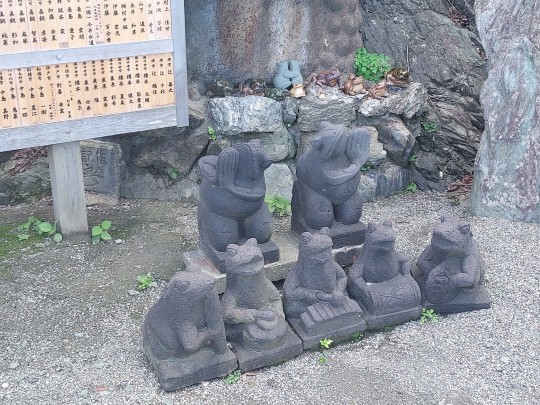
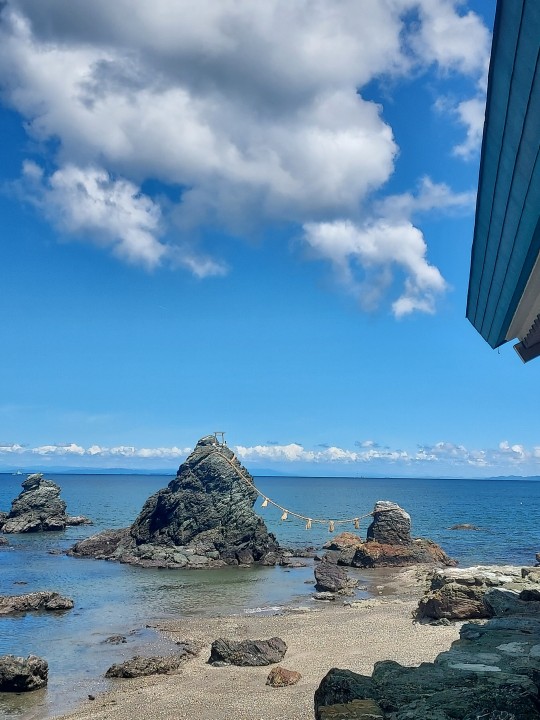
Ise shrine has been an important place of pilgrimage since the Edo era. The traditional route is to first purify yourself at Futamiokitama shrine, home of the famous Meoto Iwa "married stones", where young women pray for an auspicious marriage. The rocks represent Izanagi and Izanami, the original gods and parents of Amaterasu & co. The enshrined kami, Sarutahiko Okami, has frogs for their messenger animal, and there are frog statues and frog-decorated merch to buy. I nearly bought a tadpole-shaped omamori (might go back tomorrow for it).
Then you visit Geku shrine, dedicated to Toyouke Ohime. She is the goddess of food, clothes and homes. She was summoned and enshrined in Ise after an emperor had a vision of Amaterasu basically saying "I love it here but there's no food, bring my pal over so she can cook for me".
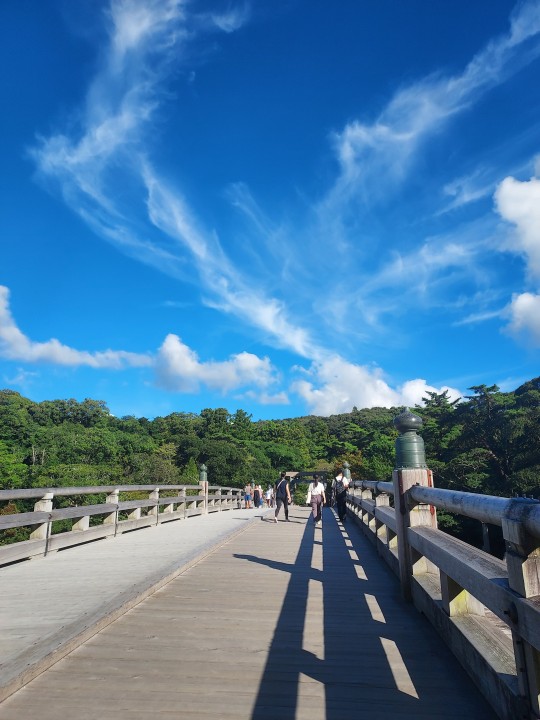
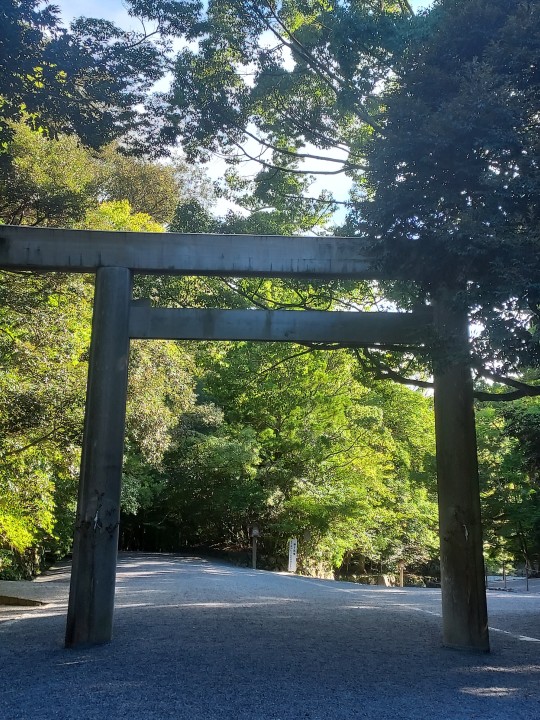
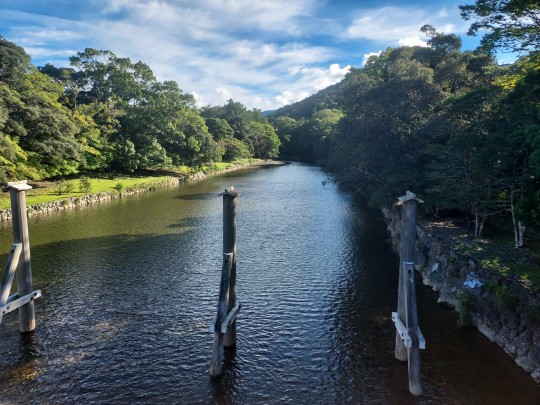
And lastly, you visit Naiku shrine, home of Amaterasu the sun goddess, protector of Japan. You can even ourify yourself djrectmy in the river rather than in a temizuya.
The shrines themselves were a little underwhelming, especially when compared with the other shrines I've seen so far. All of the buildings were made of plain wood, which is logical when you account for the fact that they're rebuilt every 20 years. You also cant see the atars, which are hidden behind walls or cloths, and there are no statues.
On the other hand, plain wooden buildings shaped like rice granaries in the middle of a forest /does/ bring you closer to nature, which is the origin of shintoism (which is at heart an animist belief). All in all, it was a important place to cross off the bucket list.
Also, tonight I can sleep on a real mattress for the first time in 10 days 🥳 And tomorrow we head back to Tokyo.
14 notes
·
View notes
Text
Yamatohime-no-mikoto ~ The woman who determined the location of Ise Jingu ~
Ise Jingu, with its history of over 2,000 years, is the most prominent among Shinto shrines. Amaterasu-Omikami, a Japanese goddess, is enshrined there.
The Nihon Shoki, the oldest formal chronicles of Japan, says that the location of Ise Jingu, was determined by a revelation from Amaterasu-Omikami herself: “I shall be here eternally”.
Yamatohime-no-mikoto was the person who received the revelation. She was the daughter of the 11th emperor. She took over her aunt’s position, and took the lead in an imperial tour to seek out a new, appropriate place to enshrine Amaterasu-Omikami.
After leaving Yamato where the emperor lived, the present-day Nara Prefecture, she and the members of her party went on northbound through the west area of Mie Pref. to the area beside the east side of Lake Biwa, in Shiga Pref.
After that, they changed the direction to head westbound and moved into the west area of Gifu Pref. They changed their direction there again and went on south through the east area of Mie Pref. along Ise Bay.
It is said that they continued their tour while staying in many regions for years and teaching rice cultivation and weaving to the people there. The result of such a tour style is that it took a long time for her tour to come to an end.
The end of her long and wandering tour was Ise, the place she finally received the revelation from Amaterasu-Omikami.
The mysterious word of “Revelation” and a woman of “Yamatohime-no-mikoto”, who achieved her mission as the leader of a unique project in ancient times, strongly fascinated me and brought me to Ise Jingu.
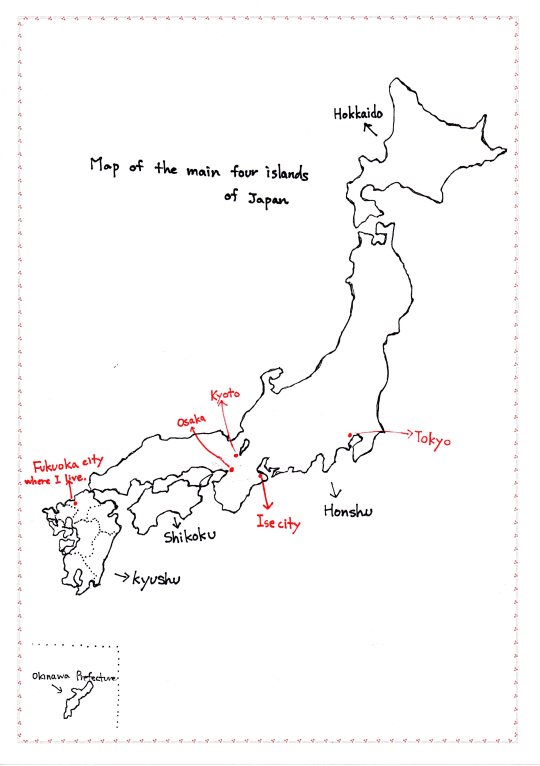
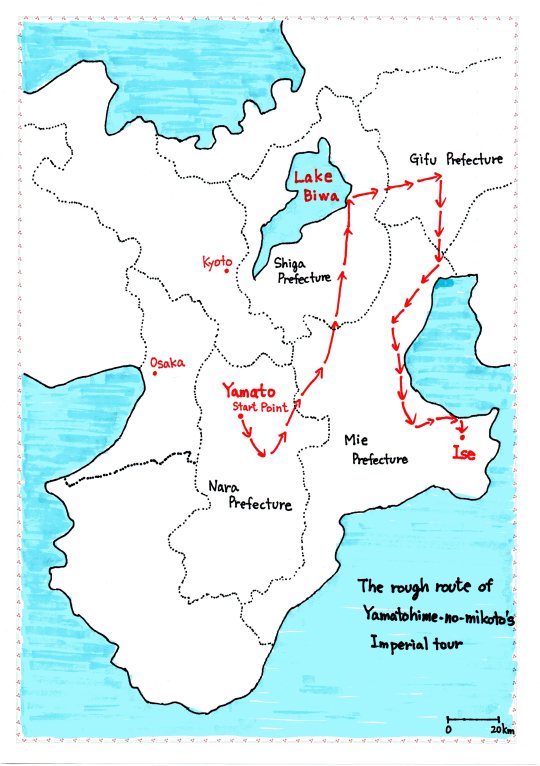
~ ❀ ~ ❀ ~ ❀ ~ ❀ ~ ❀ ~ ❀ ~
Ise Jingu includes 2 Jingus and 123 shrines. The center of Ise Jingu is two Jingus: Kotaijingu, called Naiku, where Amaterasu-Omikami is enshrined, and Toyo’ue-daijingu, called Geku, where Toyoue-Omikami is enshrined.
The total area of Ise Jingu, including Naiku and Geku and forests, is vast; it occupies approximately 20% of Ise City. The English HP of Ise Jingu says it is almost the same scale as the center of Paris.
Naiku and Geku are in different forests about 5km apart. When we visit Ise Jingu, we generally visit Geku first, and then visit Naiku. I also followed this rule.
Both Jingus were so calm and peaceful that I felt comfortable there. I enjoyed the beautiful scenery in winter.
Moreover, my visit was not only enjoyable but also meaningful: I saw lots of the hundreds-of-years old enormous trees, the main sanctuaries of Niku and Geku and other structures made from plain lumber, and Kodenchi of Geku.
*Kodenchi
Every 20 years, the main sanctuaries of Niku and Geku, and the divine places of 14 shrines that have deep relation to Naiku or Geku, are reconstructed on each Kodenchi, the previous site that is adjacent to the present site, with the same dimensions. After that, each object of worship is moved into a new one.
This reconstruction, which has the purpose not only of passing of Ise Jingu on to the next generation but also the passing on of architectural techniques, is the most important ritual event, called Shikinen-sengu.
The next Shikinen-sengu will take place in 2033. Each present site will become a vacant lot and will be called Kodenchi for the next 20 years.
Ise Jingu, which was determined by the revelation that Yamatohime-no-mikoto received from Amaterasu-Omikami 2,000 years ago, exits at the same location even now, and it gets so many domestic and foreign visitors.
How great the thing she achieved was!
~ ❀ ~ ❀ ~ ❀ ~ ❀ ~ ❀ ~ ❀ ~
My visit to Ise Jingu was impressive. The thing that has captured me even to this day is the sunshine that I saw at the Main Sanctuary of Geku.
I saw it unexpectedly. When I walked a path outside the row of trees alongside the Kodenchi, I happened to turn my attention toward the Kodenchi. I noticed the brightness seen through the half-darkness that was created by the row of trees.
It was hard for me to grasp the situation immediately. I stopped to look in that direction and gradually I realized what it was.
It was the brightness of the soft and graceful golden sunshine pouring into the Main Sanctuary surrounded by a wall. The Main Sanctuary, bathed in the sunshine was calm and spiritual.
When I saw the sunshine, I believed that Yamatohime-no-mikoto had also seen the beautiful sunshine and a spiritual scene, or landscape, or view in the sunshine in Ise after her long and tough tour, and also believed she had received the revelation then.
~ ❀ ~ ❀ ~ ❀ ~ ❀ ~ ❀ ~ ❀ ~
A long time has passed since I knew the person of Yamatohime-no-mikoto and her imperial tour and became interested in them. I didn’t always think of her. However, even if I forgot her, I remembered her again.
Every time I remembered her, I imagined various things that I think might be related to her and her tour: there might have been some political purposes in her tour; also, what were the tools of rice cultivation and weaving like in 2,000 years ago?, and so on.
I enjoyed such times freely because they occurred in the old age which no one knew the facts and because I didn’t need to be determine any conclusions accurately, since I’m not a researcher.
~ ❀ ~ ❀ ~ ❀ ~ ❀ ~ ❀ ~ ❀ ~
The biggest mystery for me was the reason why she repeated leaving the regions where she stayed for years even though she built temporary shrines for Amaterasu-Omikami and grew rice from nothing.
She broke off all the things she had built up there, making efforts to be mindful of the people around her or to keep thinking about the things that she and everyone would do as the leader of the tour. She repeated that.
It was difficult for me to find out my own answer, but I hit upon an idea.
It might be that she and her aunt, who had sought the location for Amaterasu-Omikami for long time before her, believed that Amaterasu-Omikami would give them some kind of expression of her intension when they found the right location.
I think every region where Yamatohime-no-mikoto stayed for years was a good one. I guess she had expectations for many places.
However, when she realized she wouldn’t get any expression of Amaterasu-Omikami’s intension even if she would wait longer, she broke off everything and headed toward the next place. I consider that the long wandering tour was the result of this repetition.
~ ❀ ~ ❀ ~ ❀ ~ ❀ ~ ❀ ~ ❀ ~
I guess the people who sent her on this tour must have asked her about her progress many times, half-giving up and half-rushing. However, I believe it must have been herself who felt the most frustrated.
How disappointed she must have been when she left the places where she stayed at for years! In spite of being in such situations, she didn’t give up.
When I imagine the difficulties and repeating disappointments she experienced, I can’t help but admire her strong will.
At the same time, I think of how she must have felt when she received the revelation. How relieved she must have been at the time!
I believe that she was looking at the celestial sunshine and spiritual scenery that the sunshine created, which were more than enough to make up for all her struggles and difficulties, when she finally received the revelation from Amaterasu-Omikami.
~ ❀ ~ ❀ ~ ❀ ~ ❀ ~ ❀ ~ ❀ ~
The sequel to the story about Yamatohime-no-mikoto
Yamatohime-no-mikoto kept staying in Ise and serving Amaterasu-Omikami after having fixed the location for enshrining Amaterasu-Omikami.
She led the constructions of other shrines in Ise Jingu, organized the various rituals of Ise Jingu that have been performed to the present time, and determined the offerings for Amaterasu-Omikami.
She was considered as the origin of a system of Saio in later periods; Saio was an unmarried imperial princess who served for Amaterasu-Omikami in place of the emperor at Ise Jingu.
In 1923, the people involved in Ise Jingu and the people of Ise, who had thanked Yamtohime-no-mikoto and her achievements, built Yamatohime-no-miya, a shrine, to deify her. I like this story.
I think Yamatohime-no-mikoto would definitely say, “I did just what I should do”, but at the same time, I believe she would be touched deeply by their appreciation for her.
Yamatohime-no-miya is in a forest between Naiku and Geku.
It was a beautiful shrine and suited to her: the simple and graceful divine place, the long and wide approach to the divine place, the well-maintained forest on both sides of the path, the singing of birds and the sunlight that filtered through the leaves of trees and poured onto the stairs toward the divine place.
They made me feel the people of Ise’s deep appreciation of her. I felt a great sense of relief there.
倭姫命(やまとひめのみこと)
~ 伊勢神宮の場所を決めた女性 ~
二千年以上の歴史を持ち、神社の最高位にある伊勢神宮。そこには、天照大御神という女神が祀られています。
日本最古の正史である日本書紀によると、伊勢神宮は、天照大御神自身の「ここに居ようと思う」というにお告げによってその場所が決まったということです。
お告げを受けたのは、倭姫命(やまとひめのみこと)という女性。第11代天皇の皇女で、伯母の仕事を受け継ぎ、天照大御神を祀る新たな場所を探すための巡幸を行った人です。
彼女と一行は、天皇が住むヤマト、現在の奈良県を出発し、三重県の西側の地域を通り、滋賀県の琵琶湖の東側の地域まで北上。その後、東へ進行方向を変え、岐阜県の西部に入ります。そして再び進行方向を変え、愛知県を通り三重県東部を伊勢湾沿いに南下しました。
幾つもの地域に何年も滞在して、人々に稲作や機織りを教えながらの旅だったそうです。巡幸が終わりを迎えるまでには長い時間がかかり、その最後に、彼女は伊勢で天照大御神からのお告げを受け��した。
「お告げ」という神秘的な言葉と、古代に行われた特別なプロジェクトのトップとしての使命をやり遂げた倭姫命という女性に強く惹かれ、伊勢神宮に行ってきました。
~ ❀ ~ ❀ ~ ❀ ~ ❀ ~ ❀ ~ ❀ ~
伊勢神宮には、125の神社があります。その中心は2つの神宮。天照大御神が祀られている内宮と呼ばれる皇大神宮と、豊受大御神が祀られている外宮と呼ばれる豊受大神宮です。
内宮と外宮、そして神宮の森を合わせた伊勢神宮の面積は広大で、伊勢市の約20%に及ぶということです。伊勢神宮英語版ホームページによると、パリの中心部と同じくらいの広さだとか。
内宮と外宮は、約5キロメートルはなれた別の森の中にあります。参拝は、一般的に外宮から内宮の順で行います。私もそのルールに則り参拝しました。
どちらも森の中にあるので、落ち着いていて気持ちがよく、冬枯れの美しい景色を楽しみながらの参拝となりました。
そして楽しいだけでなく、樹齢何百年という木々、そして、内宮と外宮の正宮を始めとした素木造りの様々な建造物、外宮の古殿地*などを見ることができ、とても有意義でした。
*古殿地
内宮と外宮の正宮、そして内宮と外宮に関係が深い14の神社の社殿は、20年毎に、それぞれの大きさを変えることなく、内宮と外宮の現在の正宮の隣にある、前に正宮があった場所(古殿地)に新たに建て替えられ、その後、ご神体がそこに移されます。
神宮を後世に受け継ぐだけでなく、建築技術の継承という目的を持つこの20年毎の建て替えは、伊勢神宮最大の行事で神宮式年遷宮と呼ばれます。
次の式年遷宮は2033年。内宮と外宮の正宮、そして他の14の神社の社殿が現在ある場所は、遷宮後空き地になり、その後20年間、古殿地と呼ばれることになります。
2000年前に倭姫命が天照大御神からのお告げを受け取り、その場所が決まった伊勢神宮は、今も同じ場所に存在し、国内外を問わず多くの人が訪れています。
彼女が成し遂げたことは何と大きかったことでしょうか。
~ ❀ ~ ❀ ~ ❀ ~ ❀ ~ ❀ ~ ❀ ~
印象深かった伊勢神宮参詣。その中で、今でも私の心を捉えているのは、外宮の正宮で見た美しい陽の光です。
それは偶然でした。外宮の正宮の古殿地の横にある道を歩いていた時の事です。ふと古殿地の方に目を向けると、木立の薄暗がりの先が妙に明るいことに気が付きました。状況がよく呑み込めなかったので、立ち止まってその方向を見つめていると、次第にわかってきました。
それは、塀で囲まれた正宮に降り注ぐ、柔らかで気品に満ちた金色の陽の光の明るさだったのです。そして、その光に抱かれた正宮は、とても静かで神秘的でした。
そしてその時、私は、倭姫命は長く大変な旅の後、伊勢の地で美しい陽の光と、その光が作り出す神秘的な情景か景色、あるいは風景を見たのだと、そして、その時お告げを受けたのだと思ったのです。
~ ❀ ~ ❀ ~ ❀ ~ ❀ ~ ❀ ~ ❀ ~
倭姫命と彼女の巡幸を知り興味を持ってから、長い時間が経ちました。いつも彼女のことを考えていたわけではありません。ですが、忘れてもまた思い出すのです。思い出す度に、彼女や彼女の巡幸に関係ありそうなことを色々な事を考えました。
例えば、彼女の巡幸には他の目的があったのではないかとか、2,000年前の稲作や機織りの道具はどんなものだったのだろうとか。
本当のことは誰も知らない時代の事ですし、私は研究者ではないので正しい答えを出す必��もないので、自由に想像ができて楽しい時間でした。
~ ❀ ~ ❀ ~ ❀ ~ ❀ ~ ❀ ~ ❀ ~
私にとっての最大の謎は、彼女が何年も滞在した地を去ることを繰り返した理由でした。天照大御神を一時的に祀る神社を建て、恐らく一から田を作ることから始めて、米作りをしていたのでしょうに。
彼女は、巡幸の長として周りに気を使い、やるべきことを考え続ける、そんな努力をして創り上げた、神社、米作り、人間関係、全てを終わりにして、次の土地へと向かうことを繰り返したのです。
その謎にする自分なりの答えを見つけることは中々できなかったのですが、ある時思いました。
倭姫命、そして彼女の前に、やはり長い年月をかけて天照大御神を祀る地を探した彼女の伯母は、もし彼女達が天照大御神に相応しい土地を見つけた時には、天照大御神から、何らかの意思表示があると考えていたのではないかと。
倭姫命と一行が何年も滞在した土地は、どこも良い所だったのだと思います。彼女の中では、候補地は幾つもあったのではないでしょうか。
しかし、それ以上そこに留まっても天照大御神からの意思表示を得られないと考えた時、彼女は全てを断ち切り、次の土地へと向かった。その繰り返しの結果が、あの長い長い旅だったということなのだと思うのです。
~ ❀ ~ ❀ ~ ❀ ~ ❀ ~ ❀ ~ ❀ ~
倭姫命をこの巡幸に送り出したヤマトの人々からは、何度も進捗状況の問い合わせがきていたことでしょう。半ば諦めたように、半ばせかすように。しかし、一番焦りを感じていたのは、彼女自身であったであろうと私は思います。
何年も滞在した土地を去る度に、彼女はどれほど気落ちしたことでしょう。そんな状況にいたにも拘わらず、倭姫命は諦めなかった。倭姫命が経験した困難と繰り返す失望を想像する時、私は彼女の意志の強さを尊敬せずにはいられないのです。
そして、伊勢で天照大御神のお告げを受けた時の彼女の気持ちを思います。どれほど安心したことかと。そしてその時、彼女は、それまでの苦労や困難を埋め合わせるに余りある、美しい陽の光と、その光が創り出す美しい光景を見ていた。私はそう思っています。
❀ 倭姫命の話の続きとして ❀
倭姫命は天照大御神を祀る場所を定めた後も、伊勢に留まり天照大御神に奉仕しました。伊勢神宮にある他の神社の造営を指示し、現在まで執り行われている様々な神事を整え, 天照大御神��の供物を定めたのは彼女です。
彼女は後に制度化された斎王、伊勢神宮で天皇の代わりとして天照大御神に奉仕する未婚の皇女の起源の人物だと考えられています。
大正時代の1923年、倭姫命と彼女の功績に感謝する伊勢神宮の関係者と伊勢の人々は、倭姫宮という神社を造営し、彼女を祀りました。私はこの話が好きです。
倭姫命はきっと「私はやるべきことをやっただけです。」と言うと思います。ですが、彼らの感謝の気持ちをこの上なく嬉しく思っていると思うのです。
倭姫宮は内宮と外宮の間にある森の中にあります。
広く長い参道、手入れの行き届いた参道の両側の森、静けさの中の鳥のさえずり、社殿に上る階段に落ちる木漏れ日。倭姫命への伊勢の人々の気持ちを感じさせる、美しく、倭姫命に相応しい神社。心が温かくなりました。
2 notes
·
View notes
Text
LAST TIME ON CHINESE MYTHOLOGY KAI!
The water god Gonggong was a sore loser and decided to make everyone suffer because of it, destroying Mount Buzhou with his thick head and causing the heavens to fall. Luckily, the great goddess Nuwa was able to repair the sky with a combination of molten rock and severed limbs, but the mortal world is still in great peril.....
Ah, the flood myth. A staple in most Indo-European myths from Noah to Utnapishtim. The widespread prevalence of such a specific myth structure implies there was an actual flood of massive proportions in that part of the world, and here we see evidence that it may have gone as far as East Asia. Most flood myths are focused on the idea of a cleansing apocalypse, with the gods becoming angry at how sinful humanity is and wanting to start over. While there are versions of the Chinese flood myth with this same inciting incident, many also blame Gonggong knocking down the heavens as the cause. For our purposes today it doesn't really matter how or why it happened, just that there's water everywhere.
According to one of my sources, the flood actually takes place directly after the debacle with the 10 Suns, which had gotta be a real kick in the teeth. Like, we just got rid of the unbearable heat and yeah, we did want water, but not THIS MUCH! As a side note, perhaps this can give a bit of context as to why Gonggong and Zhurong were fighting. It may have had something to do with the devastation caused by the suns and how to fix it, with Gonggong losing and then trying to do things his way anyway in the most needlessly destructive way possible.
Anyway, no matter the reason there's water water everywhere and not a drop to breathe, so humans are unsurprisingly drowning. Seeing this, the human emperor decided to try and find someone who could help. Nuwa was apparently taking a nap or something after fixing the sky, so he had to find someone else. He ends up going to this guy named Gun, apparently the grandson of the Yellow Emperor. Gun get the idea to go to the heavens and steal some divine dirt, much like Prometheus. However, also like Prometheus, he's caught and punished for his theft. Even worse, he doesn't even get to use his magic dirt and full on dies. Yikes. Supposedly his executioner was Zhurong, who started this whole mess in the first place by fighting with Gonggong. Great work bud, super helpful.
Luckily, Gun's death wasn't the end as he was apparently.... pregnant, I guess? Because after his corpse had been sitting there a while a healthy baby boy popped out, ready to take on the world! This boy was Yu the Great, a significant Chinese culture hero and mythical Emperor. Due to his achievements later in this myth, he is also called Yu the Engineer.
So Yu is born out of his dad's corpse, and apparently even though Gun was executed for stealing the magic dirt it wasn't actually confiscated, so Yungets his hands on is pretty quick. Either that or the current ruler of the heavens just... likes Yu more, I guess? And gives him some magic dirt. I think it would be cool if Nuwa snuck him some of the stuff becuase she thought the ruler of the heavens was being stupid and she didn't want the humans she'd created to all die becuase of the stick up his butt. Either way, Yu has some and starts spreading it around. Wherever the dirt touches the flood waters, it creates new land for people to stand on. He uses the new land to make dams, likes, and canals to guide the waters to the ocean.
In some tellings, Yu uses a large staff to measure the waters as he controls the flood. This is yet another possible origin story for the Ruyi Jingu Bang that Sun Wukong stole borrowed from Ao Guang. This is why some scholars speculate that the Monkey King is the reincarnation of Yu the Great. Personally I'm not that into it and prefer Wukong to just be his own special kind of wierdo, but it's a legitimate theory. You decide whether you like it or not.
Anyway, the flood waters recede and humanity can finally get back to their normal life.
For real this time.
Probably.
Sh*tpost Masterlist
#mythology sh*tposting#lmk#lego monkie kid#chinese mythology#sun wukong#journey to the west#mythology#jttw#chinese myth character inspo#gonggong#zhurong#nuwa#yu the great#ruyi jingu bang#chinese flood myth
4 notes
·
View notes
Text
Knowing Shintoism

Shintoism is a traditional religion originated in Japan that has influenced the Japanese people’s view of the world. It is rooted in Japanese culture. Shinto means “the way of the gods” or “the way of the divine”. This is based on a belief system that everything existing in this world, whether living or not, has a spirit or also known as kami that is deserving of worship and respect. Kami can be from anything like mountains or rivers.
ITS ORIGIN
Shintoism is believed to be a religion with no founder. However, it arose with unification of Japanese people back on the 6th century BC. Shinto was created for the native religion to distinguish it from the Chinese religion and philosophy, Confucianism and Budhism. Buddhism overshadowed Shintoism as the gods were considered as manifestations of Buddha. Originally, Shinto shrines were taken care of by Buddhist priests, who mixed Buddhist rituals with Shinto practices.
In the 9th century, a new religion called Ryobu Shinto, which means the Shinto of two kinds), combined elements of Shinto, Buddhism, and Confucianism. This was established by Kukai or Kobo Daishi, with Buddhism denominating Shinto and adapting the elements of Confucianism. This is the time where Shinto became less prominent. Emperors themselves had become Buddhists and Shinto-priests became fortune-tellers and magicians.
In the 18th century, Shinto was revived as a nationalistic religion, emphasizing the emperor's divine right to rule and Japan's superiority. This is through the writings and teachings of a succession of notable scholars, including Mabuchi, Motoori Norinaga, and Hirata Atsutane. This ideology fueled Japanese military expansion before WWII.
Beliefs
The followers of Shintoism mostly believe in spiritual powers. They also believe that there are spirits living inside natural living things or places. One of the concepts they believe in is comparable to yin and yang, where everything has its opposites. These things, as they say, are meant to balance and live in harmony. Examples of these are the sun and moon, fire and water, and the world and netherworld.
Gods
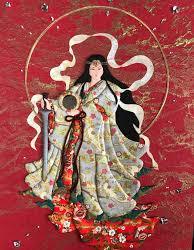
At the heart of Japanese mythology lies the story of the sun goddess Amaterasu Omikami. Amaterasu, the most revered, is considered the ancestor of the Japanese emperors. Amaterasu, also known as Amaterasu Omikami, is a superstar in Japanese mythology. Her name translates to "The Great Divinity Illuminating Heaven" – basically, the sun goddess who rules the heaven she's also known as Ohirume no Muchi no Kami, which means "The Great Sun of the Kami".
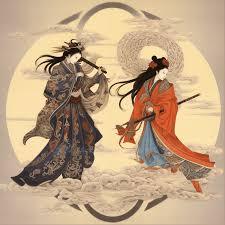
Alongside other divine spirits (kami), creation myths tell of Izanagi and Izanami birthing the Japanese islands and ancestral kami.
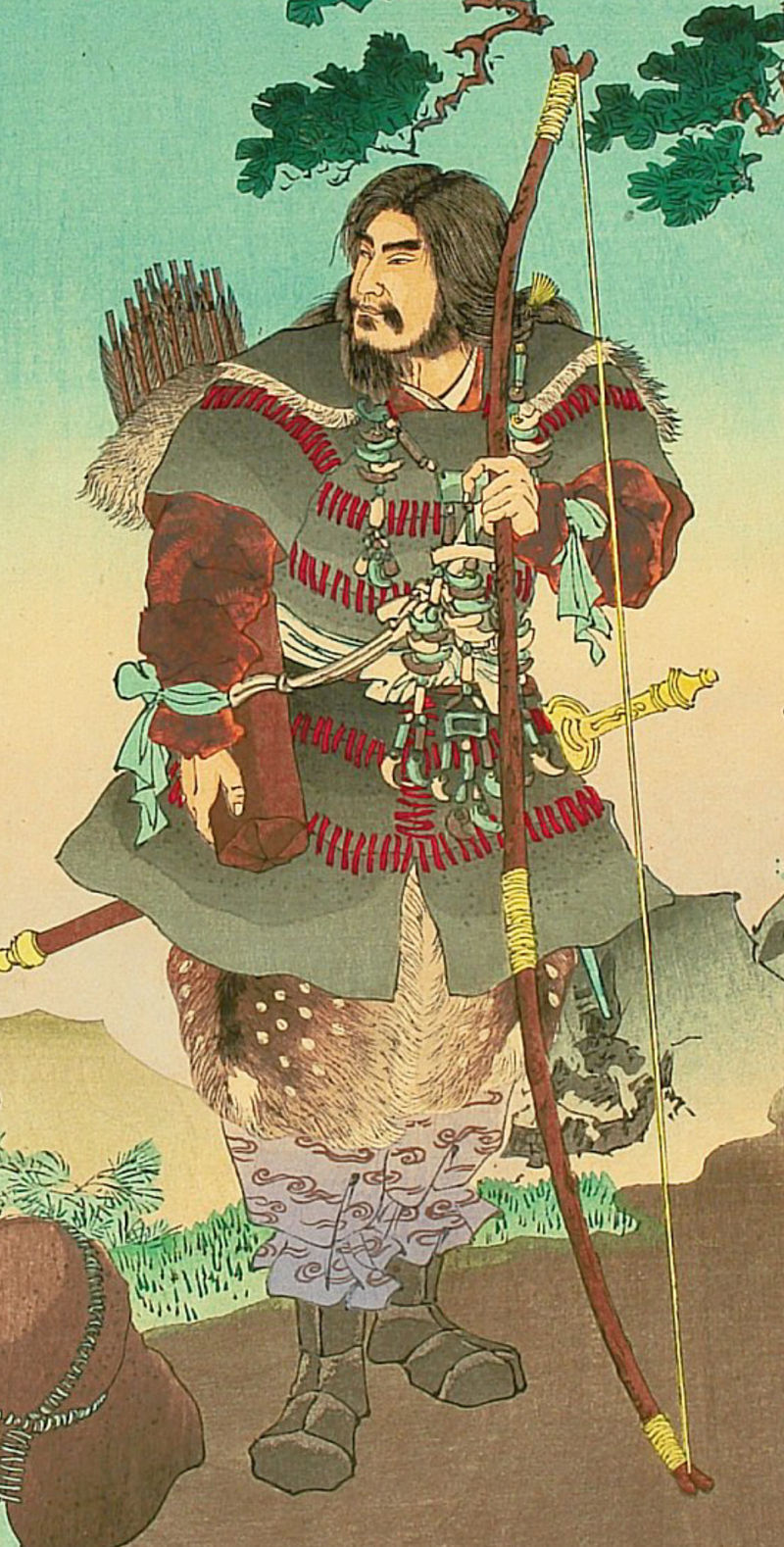
Legends recount her descendants, like Jimmu, the supposed first emperor, unifying the people.
This divine lineage is further emphasized by the Three Sacred Treasures – a mirror, sword, and jewels – passed down from Amaterasu, symbolizing the emperors' divinely ordained rule.Even today, the Inner Shrine of Ise-jingu, dedicated to Amaterasu, stands as a testament to her enduring legacy in Japanese mythology and Shinto religion.
DOCTRINES
At the heart of Shintoism lies a profound reverence for kami, the mysterious and harmonizing spirits believed to inhabit all aspects of existence. Central to Shinto belief are concepts such as musubi, the creative force of kami, and makoto, the truthful will of these divine beings. Though the nature of kami transcends human understanding, devoted followers apprehend them through faith and recognize their polytheistic manifestations. Each shrine's parishioners regard their tutelary kami as the source of life and existence, believing in their divine personalities and the power of truthful prayers to evoke responses from them. In traditional Japanese thought, truth is embodied in empirical existence and is constantly transforming. Makoto, the truthful way of kami, is discerned through every moment and encounter with these divine entities. Shinto teaches that living in accordance with a kami's will not only garners their protection and approval but also fosters a mystical power that gains the cooperation and support of all kami. However, there are some key principles and beliefs that are commonly associated with Shintoism:
Kami: Shintoism revolves around the concept of kami, which are sacred spirits or divine beings that inhabit natural elements, objects, and phenomena. These can include deities, spirits of ancestors, and even spirits of natural features like mountains, rivers, and trees.
Harmony with Nature: Shintoism emphasizes a deep reverence for nature. Nature is seen as inherently sacred, and humans are encouraged to live in harmony with it, respecting and appreciating its beauty and power.
TRADITIONS
Visiting Shrines (Omairi) Shinto shrines (Jinji) are public places constructed to house kami. Anyone is welcome to visit public shrines, though there are certain practices that should be observed by all visitors, including quiet reverence and purification by water before entering the shrine itself. Worship of kami can also be done at small shrines in private homes (kamidana) or sacred, natural spaces (mori).

Purification (harae or harai) It is a ritual performed to rid a person or an object of impurity (kegare). Purification rituals can take many forms, including a prayer from a priest, cleansing by water or salt, or even a mass purification of a large group of people
Kagura (Ritual Dances) Kagura is a type of dance used to pacify and energize kami, particularly those of recently deceased people. It also is directly related to Japan’s origin story, when kami danced for Amaterasu, the kami of the sun, to coax her out of hiding to restore light to the universe. Like much else in Shinto, the types of dances vary from community to community.
FESTIVALS
Matsuri A matsuri is a traditional festival that honors the Japanese gods with processions, dances, performances, and parades. Usually accompanied by yatai, games, and beverages, this religious celebration takes a very colorful turn. In Japan, matsuri are held throughout the year.
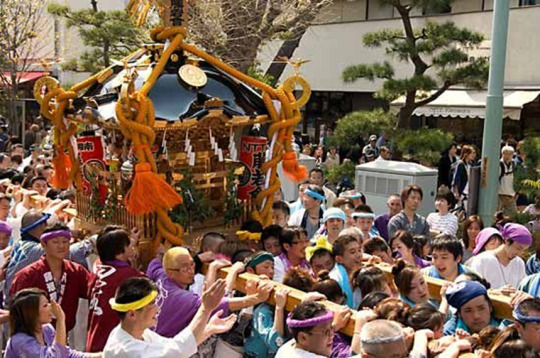
Spring Festival (Haru Matsuri, or Toshigoi-no-Matsuri; Prayer for Good Harvest Festival) Springtime (January to May) is a period for haru matsuri, or festivals, many of which revolve around the sowing of crops. Around the nation, various shrines celebrate on different days. This springtime ceremony provides an opportunity to thank the gods for a bountiful harvest.
Autumn Festival (Aki Matsuri, or Niiname-sai; Harvest Festival) During the late summer and early fall, there are several aki matsuri, or autumn celebrations, where people praise the kami for a bountiful crop. Around the nation, various shrines celebrate on different days. The Imperial family performed rites at the festival's initial harvest celebration to express gratitude for a bountiful crop production
Annual Festival (Rei-sai) This is an annual celebration that falls on a certain day that is significant to the shrine hosting it. During this celebration, the local kami are paraded through the town or village in effigy while riding on an elaborate litter known as a mikoshi, which resembles a sedan chair. There are frequently musicians and dancers accompanying the procession, and the event is joyous overall. Within the shrine, more solemn rites are held.
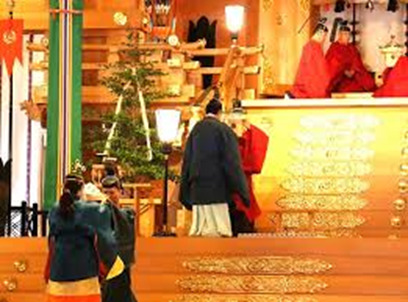
Divine Procession (Shinkō-sai)
A mikoshi, or "divine palanquin," is frequently seen in the processions carrying a kami or an image of a kami. A common description of the mikoshi is that of a transportable altar or shrine.
The local community that is devoted to the kami of the shrine is visited by them during the mikoshi parade, which is believed to bestow a blessing onto them.
Since Shinto's roots lie in Japan's agricultural antiquity, the majority of its festivals coincide with the agricultural seasons
3 SECTS OF SHINTOISM
Shrine Shinto, is the oldest way of practicing Shinto, is like visiting special buildings called shrines to honor spirits of nature and ancestors (kami) with gifts and ceremonies. It's been around for a very long time and is connected to Japan's royal family. This type of Shinto puts a lot of importance on living in balance with nature. This sect is also called Jinja Shinto.
Sect Shinto, also known as Shuha Shinto, is a bunch of newer Shinto groups that started in the 1800s. Unlike Shrine Shinto, these groups often have a clear leader, specific beliefs, and organized structures. After World War II, even more groups popped up, with some wanting to bring back old practices, some mixing Shinto with other religions, and others focusing on healing through faith.
Folk Shinto, or Minzoku Shinto, is all about honoring kami in your daily life, especially in rural areas. People show respect to small statues on roadsides and perform rituals during different parts of the farming year to bring good harvests and keep their families safe. These traditions are often passed down from parents to children and continue within communities.
1 note
·
View note
Text
Thursday 9th May - Day 3
This is day 1 proper of our holiday, the previous two days being all about travel! We get to meet our guide Myumi and our Tour Manager Mark and the rest of our group, there was just one surprise, most of us being of similar age and previously well travelled, and it was the size of our group, 33 people when we had been told that it was a group of 19. After talking with other members of the group they had been told other numbers but only up to 25. Why had we not been told the truth? An early start and we headed out by bus for our first visit to the district of Asakusa, home to Tokyo’s oldest temple, Sensoji. The temple was founded in AD645 and enshrines a golden image of Kannon, the Buddhist goddess of mercy. The approach to the temple is through the Kaminarimon Gate, which leads to the Nakamise, a shopping street which provides visitors with a variety of snacks and souvenirs.
The reason that this temple was located here is, according to legend, that two fishermen brothers working in the river found something in their net, they didn’t know what it was and so threw it away. They continued to fish but did not manage to catch any fish but the strange object kept appearing in their nets again & again. They took the item home and showed it to the village headman who said that it was a statue of Avalokitesvara Bodhisattva A small temple was formed which resembled a small hut and over time it was developed until it became the large temple that can be seen today, the statue itself was hidden and has never been seen since.
Our lunch was to be our first taste of sushi in Japan and we had to make it ourselves! What we were making is referred to as ‘instant sushi’. Originally the sushi technique was used to preserve large amounts of fish to ensure that the fish remained safe to eat, salt and rice was added to it and fermentation took place over a couple of months. Sushi is often traditionally eaten with Saki. We were advised by Myumi that the traditional method meant that the end result did not look very appetising.
We headed to a small restaurant in a side street which was ready to take us through the steps required to make our lunch. First we had to wear a hat and apron, so stylish, and clean our hands with a warm flannel. Step by step we were taken through rolling sticky rice into a ball, placing it in the centre of the fish strips, flattening and making it look appetising. Wasabi paste was provided as an optional extra, for those brave enough to try it! By the end of the class we had some reasonable looking lunch which we tucked into alongside a bowl of miso soup, which is rather salty!
Back on the bus and we were heading for Japan’s most famous Shinto Shrine, Meiji Jingu. The shrine is dedicated to the Emperor Meiji, and is situated in a large forested area consisting of more than 100,000 trees, gifted by the people to their beloved Emperor. The area that the shrine is situated in is beautiful as the variety of trees, their colours and textures make an impressive display. The main beliefs of Shinto are the importance of purity, harmony and respect for nature, family respect and the subordination of the individual before the group. Food, money and prayers are offered up at the temples.
We arrived back at our hotel at around 3pm, an hour or so ahead of schedule as this week the tourist sites are very quiet and so we are not having to queue to see them. The weather today was damp this morning but it brightened up in the afternoon. Jet lag meant that we headed for a couple of hours rest before meeting up with everyone for a Welcome Drink. We received an overview of the itinerary over the next few days and headed out for dinner with Mary & John.
After walking around we decided to head into a small restaurant that seemed popular with the locals. The restaurants have long tables, divided up with menu stands and so you sit wherever there is a space! Smoking is rife in the restaurants, strange to us westerners! We were handed an English version of the menu and as always the translations are interesting and a bit confusing!
Plum shark cartilage
Innards Stew
Fatty Taku Maki Roll
Pickled Wasabi on a stem of long potato
Toughness etc 🙂
Having chosen some of the tastier sounding dishes we waited to see what would arrive! Kebabs, fries, crab croquettes, squid followed by matcha ice cream … the main course was quite tasty but the matcha ice cream less so!
Myumi shared a number of interesting facts with us about Tokyo & the surrounding area:
Shinjuku train Station is the busiest in the world, used by 4m people a day ****
Most Japanese people use the underground or overground train lines to move around the city. The service is extremely efficient, on time and exceptionally clean.
Shinjuku is the entertainment area of the city
The roads have very long underground tunnels to enter & exit the city, they run for miles & miles.
The Japanese drive on the left!
10% of the country’s population live in Tokyo
37m people in Tokyo and surrounding area
Most people start work 8.30/9.30 - 5.30/6.30. There is a surge of people moving between their offices and the station at these times of day.
Tokyo has 3 university hospitals.
If needed the Emergency Services telephone number is 119
Housing costs in Tokyo. Myumi told us that her daughters rent is Y120,000 per month for a compact 2 bed apartment, she is fortunate as her company pays 90% of her rent
Cleanliness is godliness - every morning shop owners and restaurant owners clean the local streets hence a litter free environment










0 notes
Text
Of Dragons and Girls (and 3)


Dear Caroline:
We already started talking about the third iteration yesterday. In a traditional folktale, third time's the charm, and generally, the third brother/sister is genuinely 'pure of heart', usually overtly naive, generous, agreeable and even (according to the ways of the world) 'stupid'. As a daughter of a postmodern world, though, you are seeking for a different type of closure, which would be some witty reversal of expectations with winks to the 4th wall, satisfying the letter but also going beyond the spirit of the initial rules of the game, and updating the moral of the fable to more current values.
One way of subverting 'purity of heart' would be equivocating it with sincerity, with hiding nothing away, with seeing and stating everything 'as it really is' without second thoughts for self, pride or social and moral expectations. I can imagine the third daughter anticipating what the dragon is going to say, and some more, and leaving her soul as an empty room, stashing nothing away. But this is probably how I would have written the scene, with my own obsessions with truthiness. Your take is a different reframing, which also comes with a certain emptiness - a Greek temple without the idol inside, or more appropriately, classic philosophical tropes about the continuity and stability of self. Plutarch talks of the Ship of Theseus, whose general form persists when all of its original elements have been taken away. The Japanese make the same sort of argument with Ise Jingu, the sanctuary to the greatest goddess of the land. The original design and architecture of the place date back to 1500 years ago, in an unbroken thread of continuity that is punctured every 20 years by a complete renovation of its wooden buildings.
Besides a general agreement on our lack of an eternal, inmutable soul (but you'd still get concentrations of traits and tendencies that would warrant the definition of some sort of stable, if not unchanging, personality), I like the notion your character presents as a 'weaver of stories': humans and our actions are inordinately complex, and it is possible to build many stories from the same building blocks of facts. This feels more like a humanities-kind of thing than I'd expect from you, and it is prone to cynicism and abuse. Some narratives feel more coherent and consistent with the world as we see it or conceive it, but then again, anything goes from a story within a story, and there's still a kernel of truth when talking about how humans (and presumably, dragons) react to how we tell stories and how we frame narratives, whether consciously or unconsciously. And we can always recur to a better narrative of ourselves and our purposes in life, which is something that these days it would profit you to be in the process of doing. And that's a treasure for you to find.
Quote:
The ship wherein Theseus and the youth of Athens returned from Crete had thirty oars, and was preserved by the Athenians down even to the time of Demetrius Phalereus, for they took away the old planks as they decayed, putting in new and stronger timber in their places, insomuch that this ship became a standing example among the philosophers, for the logical question of things that grow; one side holding that the ship remained the same, and the other contending that it was not the same.
Plutarch, Life of Theseus 23.1
0 notes
Text
#14: Ao Kuang, Dragon King of the Eastern Seas
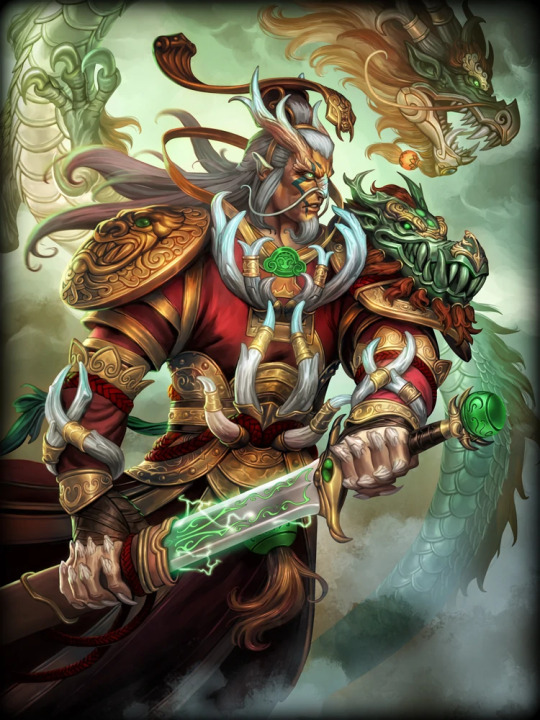
Gods and Goddesses!
We return from our journey, to once again bring divinity to your D&D game! We take our first look into the Chinese pantheon, with the Great Dragon King – Ao Kuang! This violent dragon, associated with storms and seas, may be known to some of you Journey to the West readers as the one from whom Sun Wukong received the Ruyi Jingu Bang (aka Power Pole, for you Dragon Ball weebs ;D). In SMITE, Ao Kuang is a melee mage, so let's see what we can do!
Next Time: Hey, Tumblr staff, please don't ban me. I swear there is a reason she's almost naked!
So, what do we need to play as the world's most dangerous wet noodle?
A MIGHTY SWORD: Ao Kuang is a melee fighter with magical powers and a sword that channels electricity and summons dragons to fight on his behalf.
Water Illusionist: As the dragon of storms and seas, we need to command those particular forces of nature. Ao Kuang also has the ability to set decoys and disappear from sight.
A GIANT F**K-YOU DRAGON: Ao Kuang's Ultimate lets him transform into his draconic form and rain death from above. I'll tell you right away, we won't be able to transform fully into a dragon, but we'll get the very best close second.
---
When it comes to Ao Kuang's race, I don't see any other option than Dragonborn. More specifically, we're going to use the 2021 Draconic Options Unearthed Arcana and play as a Metallic Dragonborn. We get to choose two of our abilities to boost (+2 Charisma and +1 Dexterity), and also pick our Metallic Ancestry; although the Dragon Form in the picture above is shown as green, we're going with Bronze ancestry for its Lightning damage type. We also get a Breath Weapon, a dragon standard. We can replace our melee or spell attack with a 15-foot cone of energy burst. Each creature within the cone must make a Dexterity saving throw (DC = 8 + our Constitution modifier + our proficiency bonus), or take 2d8 lightning damage (half damage on a successful save; damage increases as we level up).
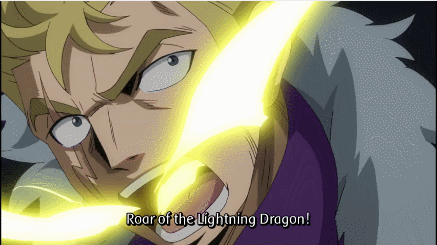
Metallic Dragonborns also get Draconic Resilience, which grants us resistance to damage type associated with our draconic ancestry, in this case, lightning. We also know Common and one language of our choice (most likely Draconic).
The regal and powerful Ao Kuang is definitely a Noble. We gain proficiency in History and Persuasion, one type of gaming set, and we learn one more language of our choice. The Position of Privilege feature grants us enough clout to walk around like we own whatever place we're in... because we probably do. It lets us secure an audience with another noble, better accommodation than others, or perhaps convince locals to fight on your behalf.
ABILITY SCORES
We'll start with Dexterity, as it's going to be our primary damage-dealing ability. We're flowing like a river, but striking swiftly like a lightning. Charisma is next, we've gained our title of the Dragon King by being intimidating as all hells and by keeping our subjects' loyalty (spoiler alert, it's also going to be our spellcasting ability). Follow that up with Constitution, we're a dragon, we need to be tough enough.
Wisdom is next, once again - we're a dragon and we're Chinese - we're practically the epitome of that trait. Strength is a little lower than I would like it, but it's fixable. Finally, we'll dump Intelligence; we're not stupid, we just need other abilities more.
CLASS
This one was another tough one. Ao Kuang is a swordsman primarily, but there are several high-level spells that fit his style and abilities. I think I've arrived at a satisfying conclusion, though, so sit back and enjoy the ride:
Level 1 - Fighter: We begin as the generic damage-dealer. Starting with a d10 Hit Dice, [10 + Constitution modifier] initial Hit Points, and proficiency with light armour, medium armour, heavy armour, shields, simple weapons, and martial weapons (I suggest going with a shortsword, because of its Finesse property). Our saving throws are Strength and Constitution, and we get to pick two class skills (Intimidation and Athletics).
Fighters begin by choosing their Fighting Style. Since Ao Kuang uses just a sword and no shield, Duelling is the style we're going to go with; while wielding a weapon in one hand and no other weapon, we gain a +2 to damage rolls with that weapon. We also get Second Wind, which lets us recover [1d10 + our Fighter level] Hit Points as a bonus action once per short or long rest.

Level 2 - Fighter: Starting at this level, we get Action Surge. It lets us take one additional action on our turn once per short or long rest. The number of extra actions we can take increases as we level up.
Level 3 - Fighter: We get a secondary racial ability, the Metallic Breath Weapon. Similarly to the other one, it covers a 15-foot cone, but this time we exhale a magical gas (Save DC = 8 + our Constitution modifier + our proficiency bonus). We get to choose one of two effects:
Each affected creature must make a Strength saving throw or be pushed back 20 feet from us, and be knocked prone;
Each creature in the cone must succeed on a Constitution saving throw or be incapacitated until the end of our next turn.
At this level, we also get to pick our subclass - our Martial Archetype. Now, I decided to go with Matt Mercer's Echo Knight to at least get the taste of Ao Kuang's duplicate ability (since we won't get access to the Mislead spell). Simply re-flavour the 'summoning yourself from another timeline' into 'creating water & vapour illusions' and we're good to go.
Echo Knight's signature ability is Manifest Echo. We summon one magical, translucent shade of ourselves that lasts until it is destroyed/we dismiss it/we're incapacitated. Our Echo has the AC of [14 + our proficiency bonus], 1 Hit Point, and is immune to all conditions. During our turn, we can move our Echo up to 30 feet in any direction (any further distance destroys it). We can use our Echo in the following ways:
As a bonus action, we can swap places with our Echo, at a cost of 15 feet of movement, no matter the distance between us;
When we take the Attack action, it can come from our Echo's space, essentially giving us 30 feet reach for our attacks;
If a creature that's within 5 feet of our Echo moves out of its melee range, we can make the attack of opportunity against it.
We also get Unleash Incarnation. When we take the Attack action, we can make one additional attack from our Echo's position. We can use this feature a number of times equal to our Constitution modifier.
Level 4 - Fighter: Time for our first Ability Score Improvement. We're not going to raise any numbers, however. Instead, we'll take the Dragon Hide feat from Xanathar's Guide to Everything. As we manifest draconic scales on our body, we get to increase one of three abilities (let's make it Constitution), and our AC while not wearing any armour becomes [13 + our Dexterity modifier]. We also gain a natural weapon in the form of our long dragon claws; we can use those to make an unarmed strike that deals [1d4 + our Strength modifier] bludgeoning damage.
Level 5 - Fighter: We gain Extra Attack. This lets us attack twice instead of once during one Attack action.
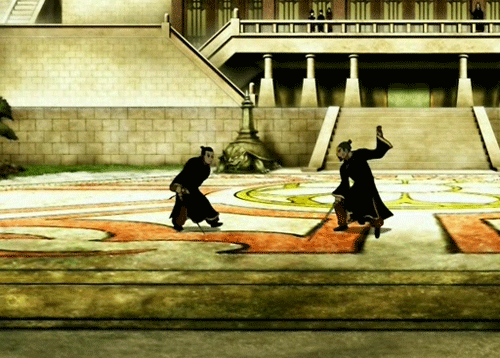
Level 6 - Sorcerer: Time to mess with some magic. In-game, Ao Kuang is not a ranged caster, so all the spells we choose here will be more in the support category. Sorcerers start with picking their subclass, their Sorcerous Origin. Since we are the Dragon King, it's only natural to pick Draconic. Sike. We're the storm lord, we're going with Storm Sorcery from Xanathar's Guide to Everything.
The Wind Speaker feature teaches us how to speak and read Primordial, the language of elementals. Tempestuous Magic gives us a flying speed of 10 feet, any time we cast a spell of 1st-level or higher. If we use this flight to escape the enemy, we do not provoke attacks of opportunity.
Sorcerers are creatures with the innate ability to control magic, therefore they start with the Spellcasting feature and know both standard spells and cantrips. We start with four cantrips:
Blade Ward gives us resistance to bludgeoning, piercing, and slashing damage until the end of our next turn;
Minor Illusion creates a sound or an image within 30 feet of us and lasts for 1 minute. The image cannot be interacted with, and a successful Investigation check reveals the illusion.
Shape Water grants us control over a 5-foot cube area of water within 30 feet of us. We can choose from several different effects: we can change the water's flow, create small shapes on its surface, change the water's colour and opacity, or freeze it for 1 hour.
Shocking Grasp sends a jolt of electricity into one target we touch. On a successful melee attack (we get an advantage if the target's wearing metal), the enemy suffers 1d8 lightning damage (damage increases as we level us) and cannot take reactions until the start of its next turn.

We start with two 1st-level spell slots, and we know two 1st-level spells:
Fog Cloud creates a 20-foot-radius sphere of dense mist within 120 feet for 1 hour (concentration). The fogged area is considered heavily obscured, effectively blinding all creatures within.
Shield can be used as a reaction to when we're being hit. Until the start of our next turn, we get a +5 bonus to our AC.
Level 7 - Sorcerer: We gain the Sorcerer's signature ability, Font of Magic. We get access to Sorcery Points (currently 2), which can be spent on our Metamagic abilities or to create spell slots. We also gain another spell slot, and we learn one more 1st-level spell: Feather Fall greatly decreases the falling speed for us and up to five falling creatures within 60 feet for 1 minute. If we reach the ground before the spell ends, we take no fall damage.
Level 8 - Sorcerer: We unlock the previously mentioned Metamagic. This allows us to burn Sorcery Points, in order to modify our spells in a variety of ways. We learn two Metamagic options from the start:
Quickened Spell: Spending 2 Sorcery Points lets us change the spell's casting time from Action to Bonus Action;
Subtle Spell: Spending 2 Sorcery Points lets us cast a spell without using verbal or somatic components.
At this level, we unlock 2nd-level spell slots and can learn one more spell: Magic Weapon gives our weapon magical properties for 1 hour (concentration), for the purpose of overcoming resistances. It also gains a +1 to both attack and damage rolls.
Level 9 - Sorcerer: We get another ASI. Let's raise our Dexterity by 2 points, to get some better AC.
We also get another cantrip: Frostbite causes numbing frost to appear on one target within 60 feet of us. The enemy must make a Constitution saving throw or take 1d6 cold damage (damage increases as we level up) and the next weapon attack roll they make before the end of its next turn is made with a disadvantage.
We learn another spell: Warding Wind creates a 10-foot-radius sphere of strong, howling wind centred on us and moving along with us. The wind lasts for 10 minutes (concentration) and has the following effects:
It deafens us and all creatures within;
It extinguished any unprotected flames;
It hedges out vapours, gases, and fogs;
The area becomes difficult terrain for creatures other than us;
The attack rolls of ranged weapons coming in or out of the wind are made with a disadvantage.

Level 10 - Sorcerer: Halfway through the build, and we unlock 3rd-level spell slots. One more spell enters our repertoire:
Tidal Wave creates a rolling mass of water that crashes down on an area within range (120 feet). The area can be up to 30 feet long, 10 feet wide, and 10 feet tall. Each creature in the area must make a Dexterity saving throw or take 4d8 bludgeoning damage and be knocked prone (half damage on a successful save and no knockdown).
Level 11 - Sorcerer: We get our Storm Sorcery upgrades. Heart of the Storm gives us resistance to lightning and thunder damage. In addition, whenever we cast a spell that deals lightning or thunder damage, storm magic erupts within 10 feet of us, dealing [half of our Sorcerer level] either lightning or thunder damage to all creatures of our choice within range.
Storm Guide gives us the ability to subtly influence the weather around us. If it's raining, we can use a bonus action to stop the rainfall in a 20-foot-radius sphere. If it's windy, we can use a bonus action to change the direction of the wind within a 100-foot-radius sphere.
For this level's spell, Lightning Bolt creates a stroke of lightning blasting in a 100 feet long and 5 feet wide line. Each creature in the line must make a Dexterity saving throw or take 8d6 lightning damage (half damage on a successful save). The lightning ignites any flammable objects.
Level 12 - Sorcerer: We unlock 4th-level spell slots here and gain one more spell:
Greater Invisibility renders our body (along with clothes and weaponry) completely imperceptible for 1 minute (concentration). Unlike regular Invisibility, this ability does not end when we attack with weapons.
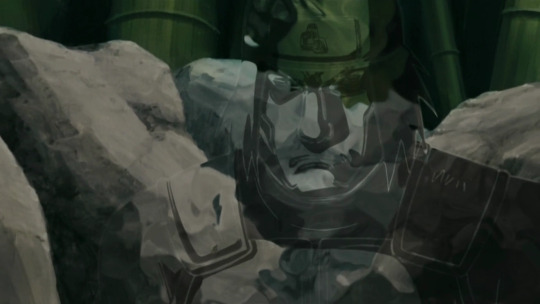
Level 13 - Sorcerer: We get another ASI here. Let's get +2 to our Constitution for better Hit Points and our racial abilities.
For this level's spell, Dimension Door lets us teleport to a spot within 500 feet of us. It can be a place we can see or visualize. We can also bring objects with us or one willing creature. If we were to arrive at a spot already occupied by a creature or an object, we take 4d6 force damage and the spell doesn't teleport us.
Level 14 - Sorcerer: We unlock 5th-level spells, and we can finally take the one spell I've been waiting for:
Summon Draconic Spirit lets us call forth a spirit that takes the form of a giant f**k-you dragon! For 1 hour (concentration) a Large dragon spirit appears in an unoccupied space within 60 feet of us and obeys our commands. This is the best we can get to portray Ao Kuang's Ultimate ability.
Level 15 - Fighter: Having obtained our dragon summon, we can come back to swinging our Mighty Sword! And we return to an ASI! Let's get a +2 to our Strength score.
Level 16 - Fighter: We get our Echo Knight upgrade. We can temporarily see and hear through our Echo's eyes and ears thanks to Echo Avatar. We can use this ability for 10 minutes and during this time we can move our Echo up to 1,000 feet from us without it being destroyed.
Level 17 - Fighter: We get another ASI. Let's get a +2 to our Intelligence to avoid negative modifiers in our sheet.
Level 18 - Fighter: We gain the Indomitable feature. Once per long rest, we can reroll a failed saving throw, but we must use the new result even if it's worse than the original one.
Level 19 - Fighter: We get our final subclass upgrade, the Shadow Martyr feature. Once per short or long rest, we can make our Echo protect another creature by sacrificing itself. Before the attack roll is made, we can use a reaction to move the Echo in front of the targeted creature. The triggered attack roll is then made against our Echo instead.
Level 20 - Fighter: Our capstone is Fighter 11, which gives us an upgrade to our Extra Attack feature. We can now attack three times whenever we take the Attack action.
---
And that is Ao Kuang, the Dragon King of the Eastern Seas. Let's see how well we've portrayed him:
I gotta be honest with you guys, I'm pretty proud of this build. I might have to pat myself on the back for this one. We have a very nice combination of sword and sorcery, with draconic flavour and good survivability. We have an Unarmoured AC of 17 (going up to 22 with the Shield spell), +4 to our Initiative rolls, and 148 Hit Points on average. None of our abilities reaches 20, but we don't suffer from negative modifiers so I consider that an absolute win. The only downside I can see is, we have very few skills and only two related to an ability we're good at.
Anyway, I hope you guys enjoyed this one, and I'll see you for the next one!
- Nerdy out!
#smite#smite gods#dnd#dungeons and dragons#d&d 5e#character building#ao kuang#ao guang#dragon#dragonborn#metallic dragon#sorcerer#fighter#echo knight#storm sorcerer
39 notes
·
View notes
Text
𝕋𝕙𝕖 𝔻𝕣𝕒𝕘𝕠𝕟 𝕊𝕖𝕒 𝔾𝕠𝕕

ɴᴀᴍᴇ: Ryujin ᴀɢᴇ/ʙɪʀᴛʜᴅᴀʏ: Unknown / Unknown ꜱᴘᴇᴄɪᴇꜱ: God ɢᴇɴᴅᴇʀ/ᴘʀᴏɴᴏᴜɴꜱ: Male / He, him ᴏʀɪᴇɴᴛᴀᴛɪᴏɴ: Demisexual / Demiromantic ʜᴇɪɢʜᴛ/ʜᴀɪʀ/ᴇʏᴇꜱ: 6′3 / Black / Teal ꜱᴛᴀᴛᴜꜱ/ᴀᴠᴀɪʟᴀʙɪʟɪᴛʏ: Single / Available
ɴᴏᴛᴀʙʟᴇ ꜰᴇᴀᴛᴜʀᴇꜱ: Tall and lean muscular frame. No piercings or tattoos. Many scars. No glasses. Unusual eye color when in human form. Dragon form is explained above.
ʙɪᴏ:
Ryūjin is the Japanese dragon god of the sea, one of the very gods that came to be from the blood of Kagutsuchi himself. Ryūjin is a proud and strong god, his emotions just like the sea and can be just as calm or as strong as a tidal wave. Usually seen wearing a midnight blue yukata with a necklace made of what is known as tide jewels (jewels that control the seas), he tends to stick close to the sea, never venturing too far from the place he feels the most comfortable. All the creatures of the sea are said to be his servants to do his bidding no matter his wishes, even if he rarely ever does demand anything of them. Though it is technically forbidden to interfere with mortals, Ryujin has from time to time gotten himself involved but because of the fact that Ryujin aligned himself with his father Kagutsuchi, Izanagi has yet to enact any form of punishment upon the god for it. There are shrines still present and even festivals held in his honor. Specifically, the Gion Matsuri festival held annually in honor of his aid to Empress Jingu when he loaned her his jewels. With them in her control, she was able to carry out her attack into Korea, first throwing the Kanju jewel into the sea causing the tide to recede, stranding the soldiers and forcing them to get out of their own ships. Once they did, she then tossed the Manju jewel in and the water rose once more to drown all the soldiers. The Japanese Imperial Dynasty is said to be the descendants of Ryujin, where his daughter, the goddess Otohime, married a hunter prince and their grandson ended up becoming the first emperor of Japan, Emperor Jimmu. There is another legend, none of these which Ryujin is ever willing to confirm or deny is that the jellyfish lost its bones because of Ryujin and in his rage crushed them when they didn’t complete a task given by him properly and every jellyfish since was born without them. In Shinto, there was even once a religion based upon him called Ryujin Shinko that worshiped him and connected him to agricultural rituals, rain prayers, and the success of fishermen. He lives in a palace under the sea, surrounded by the many creatures who live in the water though he comes up to land from time to time in order to see how the mortal realm has changed. He finds the humans fascinating yet at the same time, rather aggravatingly naïve as well. He can breathe easily underwater or on land, his body adjusting to the change easily. Though his father Kagutsuchi was the original creator of dragons, Ryujin was the one placed in charge of their handling and he takes all of his duties seriously, especially those given to him by Kagu. Ryujin has a soft spot for children, there’s just something about their purity and innocence that he finds so endearing. He walks with the same regal air as that of his father but there’s more of a quiet strength to it rather than the imposing and intimidating one of his father’s. Now, while he may not come off as formidable as his father, don’t let that fool you for their fury and rage runs through the blood of the gods and he is not someone you ever wish to anger. His powers expand further than just being able to control the seas and all that lives within it. He has the ability to control anything under the element of water, is known for controlling the weather all by the change in his mood and has been known to cause more than one natural disaster in this world. He enjoys coming to land every year during his own festival, watching the mortals as they worship him not knowing the very being of their prayers is standing right among them. Ryujin has the same thick and almost impenetrable skin as his father and instead of having just the two forms like Kagu, he technically has three. His human form is the one that most see him in, a second form that is still mostly human but where there are large blue-black wings upon his back with a long scaled matching tail. His teeth become sharp, his eyes larger with cat-like slits for pupils, and he grows from 6′3 to 7′0. His skin ends up with the same scale like gleam to it as his father, his voice growing deeper with small horns upon his head and black claws upon his hands. In his third and final form, he is a large 30-foot tall blue-black dragon with hints of bright blue throughout and vivid sea-green eyes.
2 notes
·
View notes
Text
I really like the whole...their first meeting isn’t really something that they noticed. Like, yes, Qi Yan notices that the Jingu and Shunu are girls but she doesn’t know that said girls read her poem and were impressed by her penmanship. Meanwhile Jingu and Shunu don’t even notice that Qi Yan is a girl and they certainly don’t know she’s the one that wrote that poem they found impressive.
There was no moment of staring into one another’s eyes and while fate is like “Ah, yes. These two are bound together.” There was no moment of realization of who the other is. There was nothing other than Qi Yan bumping into Shunu and then getting kicked in the shins by Qi Yan. Something mundane, boring and altogether unremarkable. And I just think that’s really nicely done. I’m very used to things that are like “AND THEN KOUHAI-CHAN SAW SENPAI-SAMA PLAY THE ORGAN AT ORIENTATION AND IT WAS VERY BEAUTIFUL AND PERFECT AND HER HEART WAS FOREVER STOLEN BY THIS SEEMING GODDESS ON EARTH” or shit like Baru literally just grabbing Hu by the chin and glaring at her in the most homoerotic fashion possible. Big, fancy moments. Ones that I dearly, sincerely I do.
But I also really love the idea that a moment that should have been noticeable and that should have meant so much was just...A fleeting and frankly forgettable moment. It’s something beautiful that slipped by before the participants even realized it was slipping by or what it even was to begin with. Which in a weird way makes it more beautiful because oh the romance of romance slipping by and oh the romance of the mundane and human.
#jwqs#clear and muddy loss of love#i am buddhist as fuck i find romance in the fleeting and mundane#because it is fleeting and mundane
6 notes
·
View notes
Text
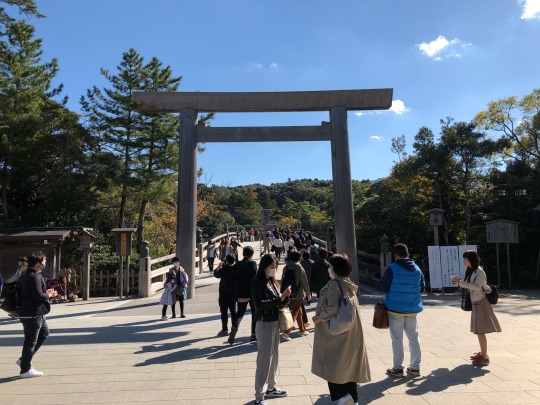
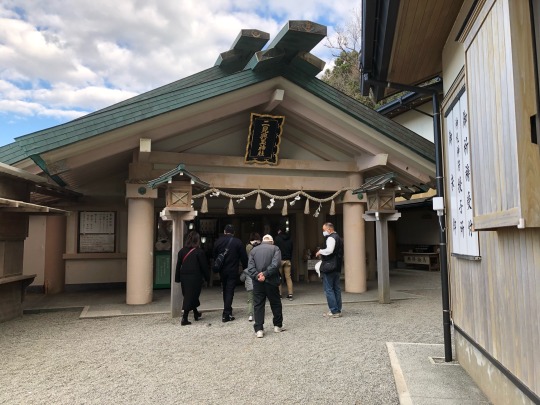


isejingu & futamiokami, mie
november 13, 2021
>> isejingu photos << >> futamiokami photos <<
earlier this month i headed up east to ise city in mie prefecture and i was able to cross off a must-see destination from my list!
ise city is famous for a few different things, but it is especially famous for its shrine, ise grand shrine, or isejingu. it’s such an important shrine that often it is just referred to as jingu, and everyone knows that it means the one in ise. it’s also famous for the wedded rocks and the pearl diving women who dive without equipment. sadly i only managed to check out the first two as i only had one full day in the city.
isejingu worships the sun goddess amaterasu. if you know your history, you may know her as the mother of the imperial family of japan, which is one of the reasons the shrine is such an important one. the chief priest/priestess is actually required to come from the imperial family; they are responsible for taking care of the shrine. one of amaterasu’s sons is the deity worshipped in izumo grand shrine, which i visited in november 2019!
anyway isejingu has about 120 shrines associated with it just within the city of ise alone, but the main two are geku (outer shrine) and naiku (inner shrine). tradition dictates that you visit geku first and then naiku. unfortunately you can’t actually take photos of anything, and there’s not much of the actual shrine that can be seen because visitors are not allowed into them. from what little you CAN see, though, it looks like there are a lot of gold accents on the buildings themselves, and it was really pretty-looking surrounded by all the trees with their fall foliage.
one interesting thing about geku and naiku is that they are torn down and rebuilt every 20 years, so while the shrine is 1300 years old, there are no buildings older than 20 years on the site.
after i visited isejingu i took a walk down okage yokocho, which is an ancient street that serves as the lead-up to isejingu for pilgrims. i didn’t take many pictures because it was very crowded, but there were a lot of neat shops and restaurants making use of the old buildings.
after all of that, i went to a third shrine called futamiokami. this shrine is where you can see the famous wedded rocks, meoto iwa. there are many famous wedded rocks or wedded natural phenomena in japan (wedded waterfalls, for example, and even wedded rocks in fukuoka), but these are the most famous. the rocks are connected by a rope called shimenawa which symbolizes the division between the earthly realm and the divine. these rocks are said to be the joining of izanagi and izanami, two sibling shinto gods who are said to have created the japanese archipeligo. they’re also the parents of amaterasu!
i really enjoyed ise. isejingu is usually the attraction that’s the main pull for folks to come visit, but honestly i really liked futamiokami the best. the shrine was beautiful and there’s nothing like a good dose of ocean!
bonus: the only proof i have that i was in aichi! i went through nagoya and had enough time to go out and do something before heading to ise, but i donthave any pictures of it 😂

#jetsettermac#mac.txt#mac.photo#nov21#mie#isejingu#ise jingu#ise grand shrine#futamiokami#meoto iwa#okage yokocho#isejingu geku#isejingu naiku#aichi
5 notes
·
View notes
Link
1. Kawaguchi Asama Shrine – Yamanashi
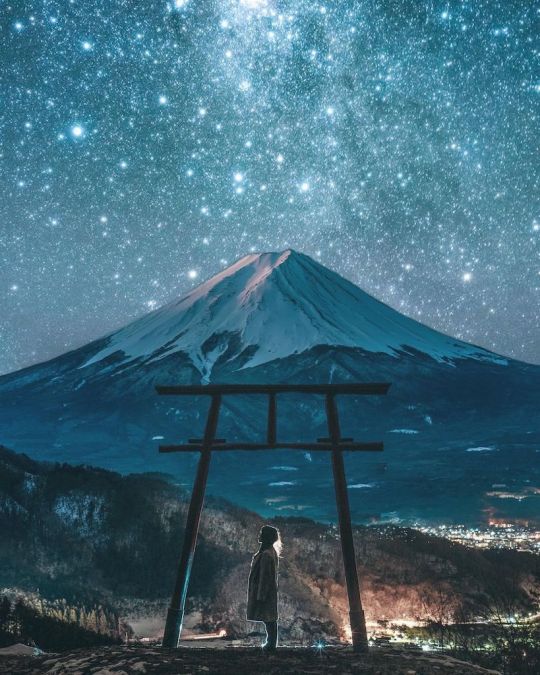
Image Credit : @kenkeno215
After a 10-day long devastating eruption of Mount Fuji in 864, Kawaguchi Asama Shinto Shrine was built the following year to worship the goddess of Mount Fuji, Asama no Okami (浅間大神).
Every year, on 25th April and 28th July, the traditional chigo no mai (稚児の舞; children’s dance) is performed to appease the god. Children aged 11 to 12 years old, typically girls, dance in front of the shrine to the tune of flutes.
2. Shirahige Shrine – Shiga

Image credit: @shirahigesup
Situated in Lake Biwa, the largest freshwater lake in Japan. Shirahige Shrine is dedicated to Sarutahiko of Mikoto, the god of longevity.
After sunset, the torii gate is lit up for 2 hours on weekends and even longer on special days such as New Year’s Eve.
3. Futami Okitama Shrine – Ise
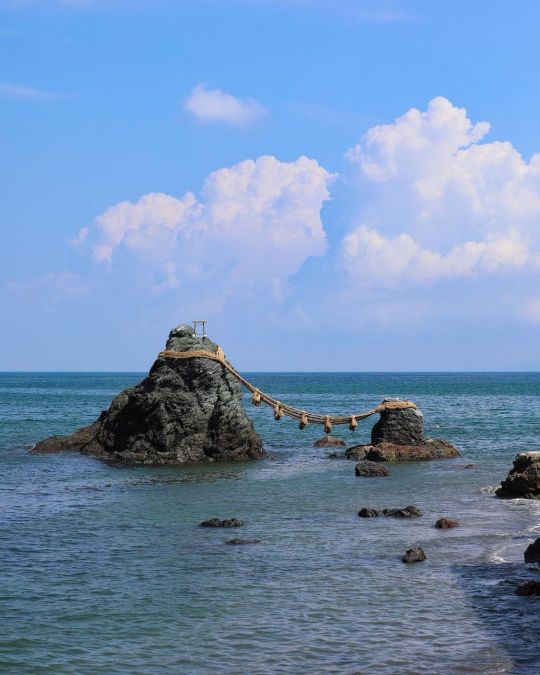
Image credit: @kenken710
Popular among newlyweds and couples, Futami Okitama Shrine is the place to be for those seeking blessings in their love life and marriage.
The Meoto Iwa (夫婦岩), or “wedded rocks” are inseparable pair of rocks – the big one representing the husband and the small one the wife – are connected by a shimenawa (sacred rice straw rope).
4. Motonosumi Shrine – Yamaguchi
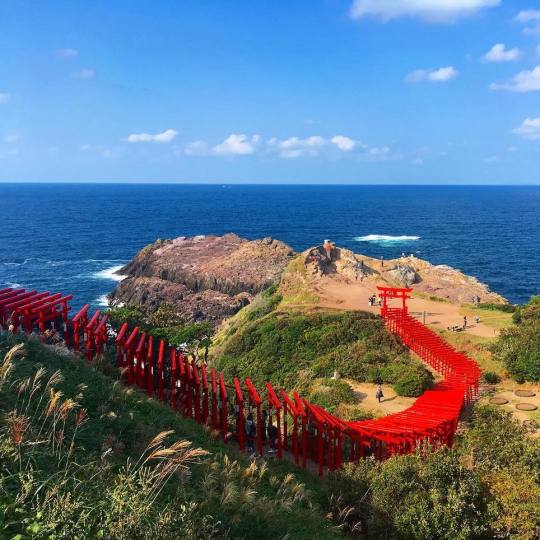
Image credit: @muracome
Legend has it that in 1955, the spirit of a white fox instructed a local to build a shrine. Obliging the deity’s request, the man built and lined 123 red torii gates along the edge of a cliff.
Today, the shrine attracts visitors who are hoping to pray for wealth, studies, pregnancy, and even fishing.
5. Takaya Shrine – Kagawa
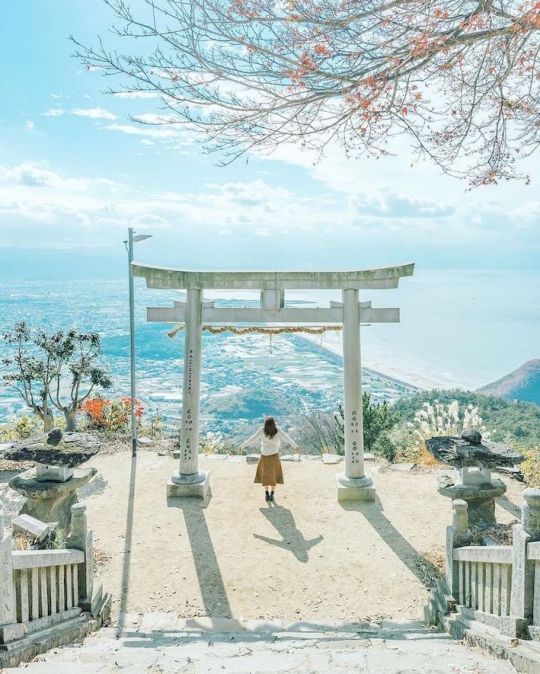
Image credit: @mitwo_310_dayo
Dubbed the “torii in the sky”, Takaya Shrine in Kagawa Prefecture sits atop the 404m-tall Mount Inazumi. The torii gate of the main shrine overlooks a panoramic view of the city of Kanonji and Seto Inland Sea.
6. Sakurai Futamigaura – Fukuoka

Image credit: @sai_._ias
While the Meoto Iwa in Ise is better known for its sunrise views, travellers flock to Sakurai Futamigaura in Fukuoka to watch the sun set.
Every May, a ceremony is held during low tide to change the shimenawa. As the rope measures over 30m in length – almost half the width of a football field – and weighs over 900kg, as many as 50 people are mobilized for the switch.
7. Udo Shrine – Miyazaki

Image credit: @tate.masa
The cliffside Udo Shrine is perched on the rocky Nichinan Coast, south of Miyazaki City, surrounded by magnificent waves.
Legend has it that Toyotama-hime, a goddess of the dragons and sea, went into labour on land. A maternity hall was built in a hurry, in a sacred cave, and Toyotama-hime gave birth to Ugayafukiaezu no Mikoto, who was later enshrined as a deity.
Today, the birthplace is better known as the main shrine of Udo Shrine. Thanks to its history, a visit to the shrine is considered to be beneficial for couples trying to conceive, and expecting mothers praying for a safe pregnancy.
8. Amano Iwato Shrine – Miyazaki
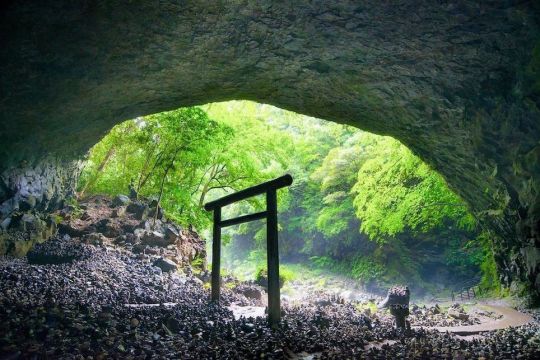
Image credit: @nobphotoo
According to Japanese mythology, the sun goddess Amaterasu hid in this cave after a destructive battle with her brother. Refusing to come out of the cave, her isolation cast darkness over the world. It was only when the other gods and goddesses came together to devise a plan that Amaterasu was lured out, returning light to the world. ��
The period between November to February is the prime time to visit as that’s when the annual Takachiho Kagura – a shinto ritual consisting of festive folk dances – is held. The main event is held on 22nd and 23rd November, but the dances are performed every night between November and February.
9. Kuratake Shrine – Kumamoto

Image credit: @ryh.photo
The remote shrine was built to protect the sea and to pray for the safety of fishermen. For that reason, you’ll find a ship-shaped vessel filled with empty shells of mina, a shellfish native to the sea of Amakusa, in front of the shrine.
Due to a flood in 1972, the mountain trail was closed to the public and only reopened in 2012. As a result, the shrine completely went under the radar, privy to only the most savvy of locals and budding photographers.
10. Naminoue Shrine – Naha
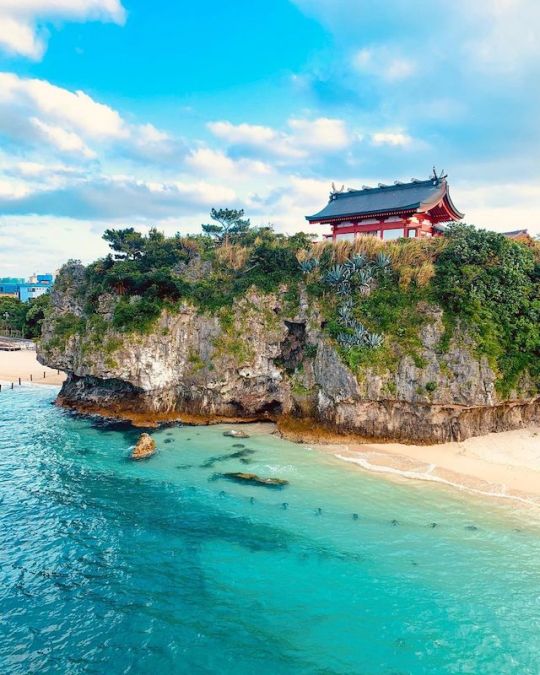
Image credit: @cliff511299
As the most prestigious shrine in Okinawa, Naminoue Shrine is widely revered as one of the 8 special Ryukyu shrines since the Ryukyu Kingdom era.
Affectionately nicknamed “Nanmin-san” by Okinawan natives, Naminoue Shrine is a power spot that can grant blessings for everything, from matchmaking to pest control. The date of the shrine’s founding is unknown, but it is believed that the roots can be traced back to when locals prayed to Nirai Kanai (ニライカナイ) – god’s world in the distance of the sea – for abundant harvests.
#underrated places in japan#kawaguchi asama shrine#yamanashi#mount fuji#shirahige shrine#shiga prefecture#lake biwa#futami okitama shrine#ise#motonosumi shrine#yamaguchi#takaya shrine#kagawa#sakurai futamigaura#fukuoka#udo shrine#miyazaki#amano iwato shrine#kuratake shrine#kumamoto#naminoue shrine#naha#okinawa#kyushu#shikoku#chugoku#kansai#chubu#japan#shinto shrine
14 notes
·
View notes